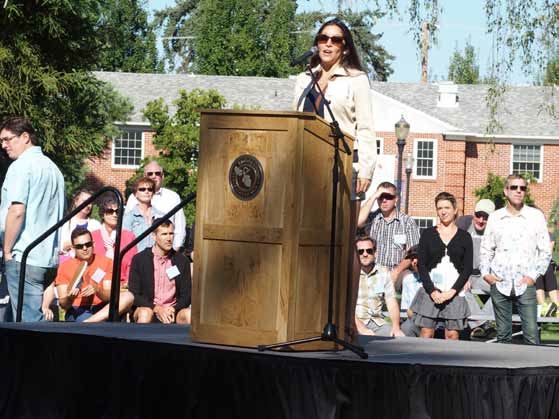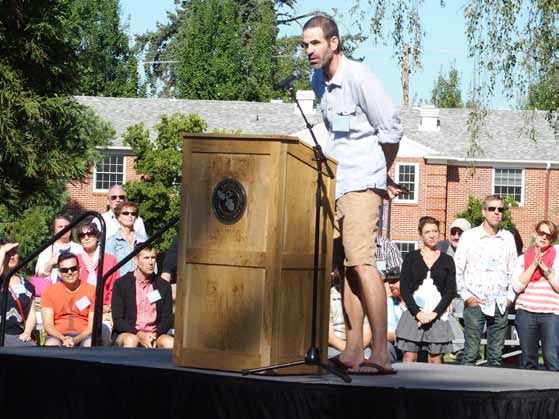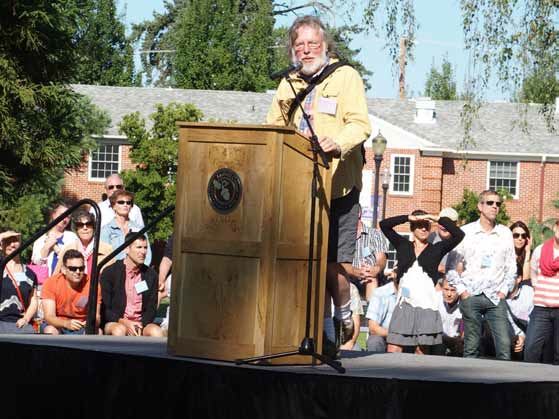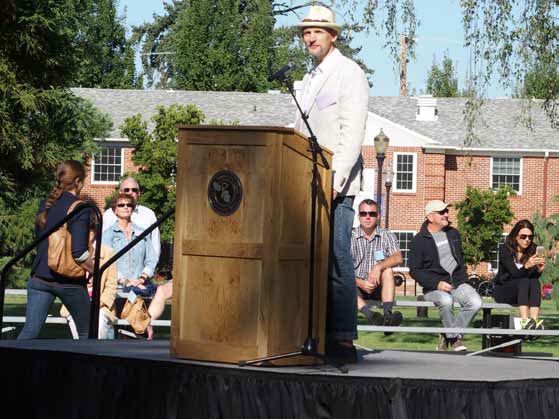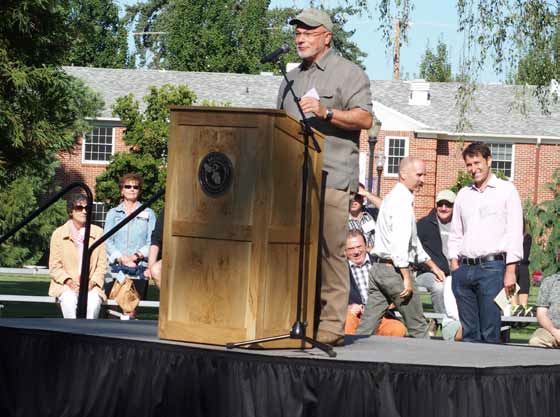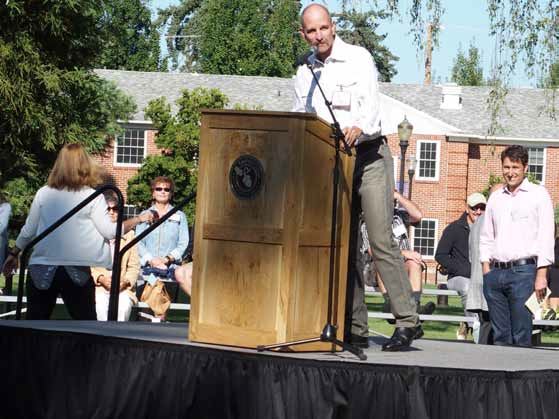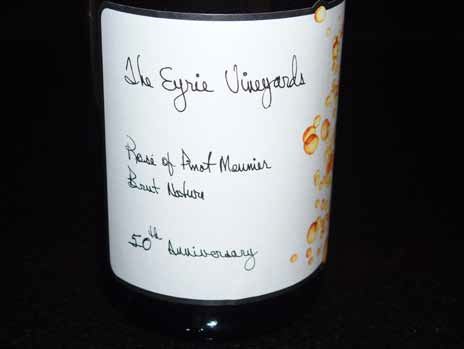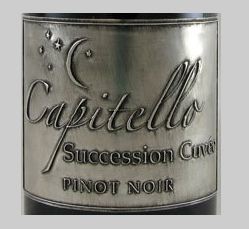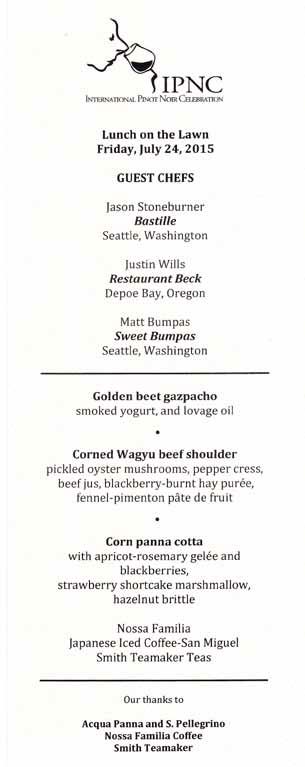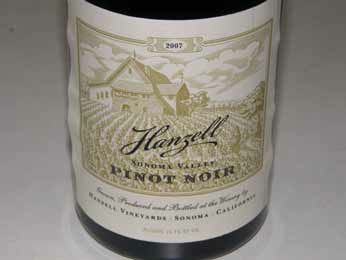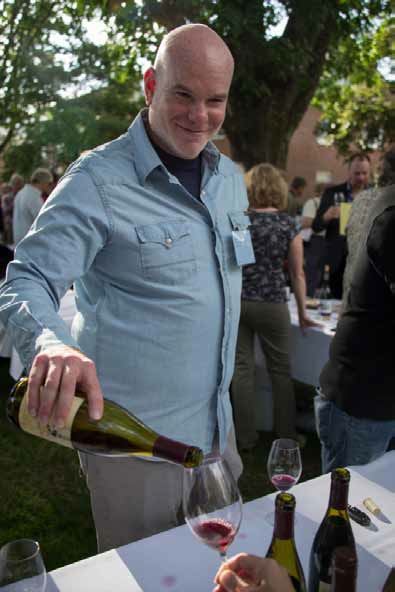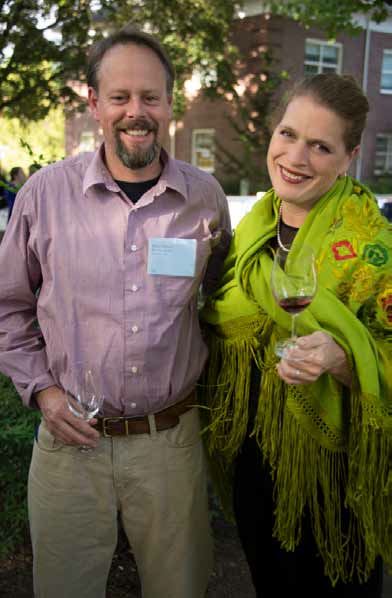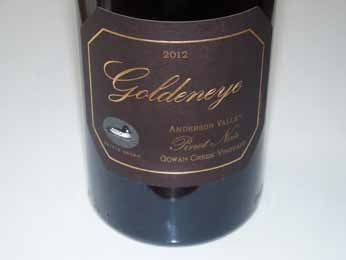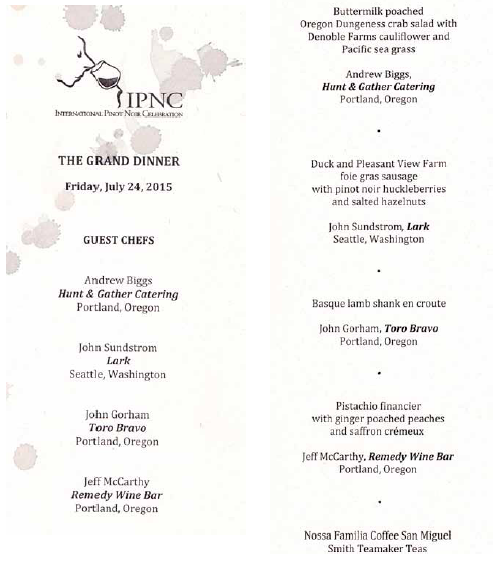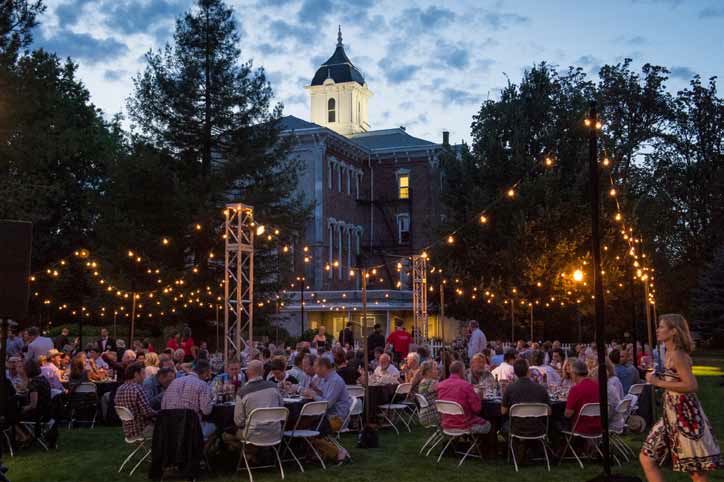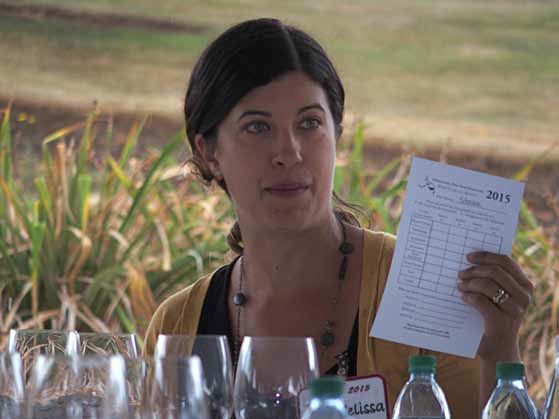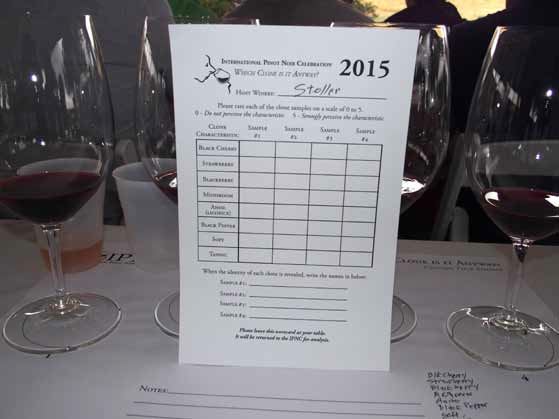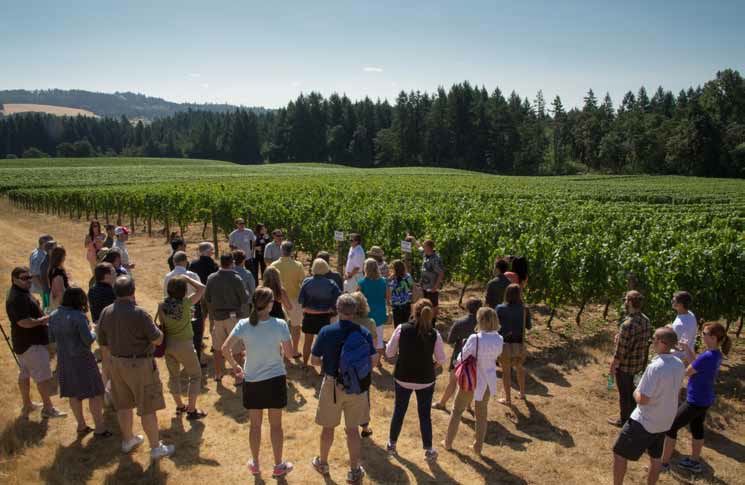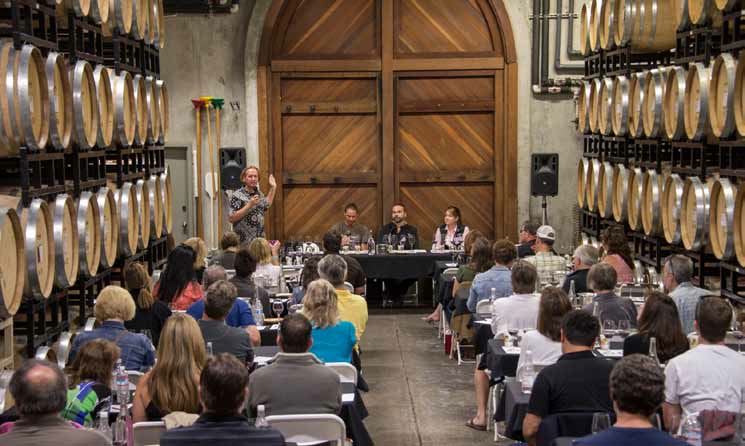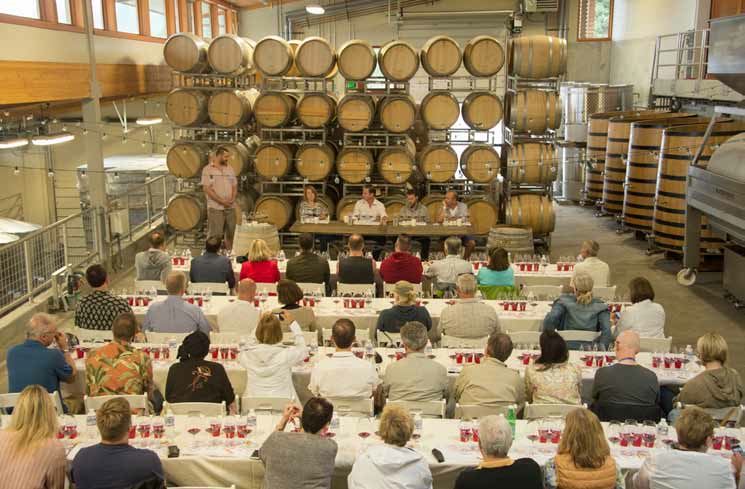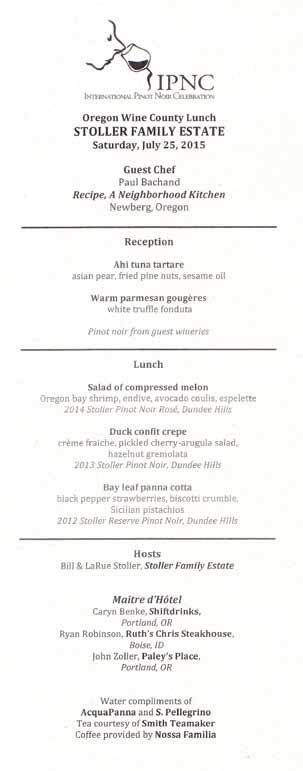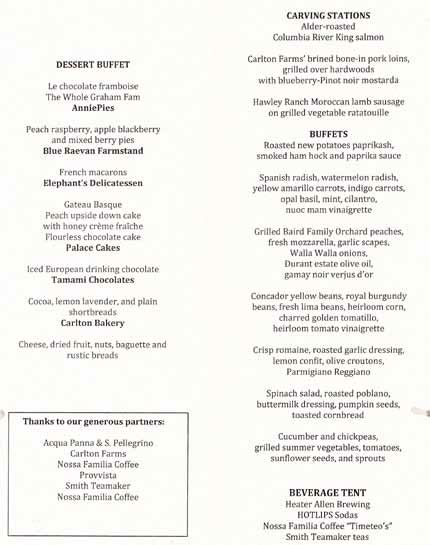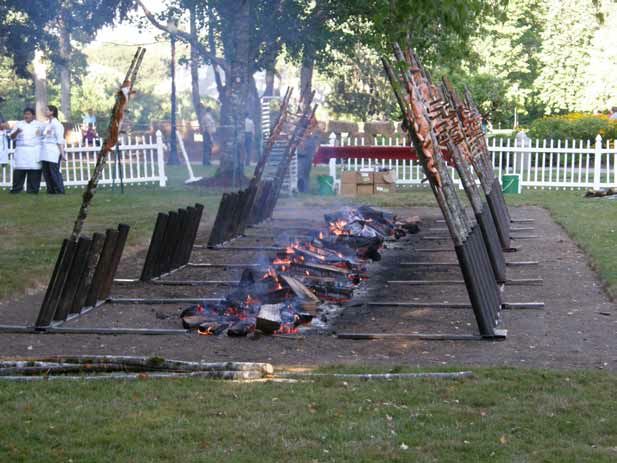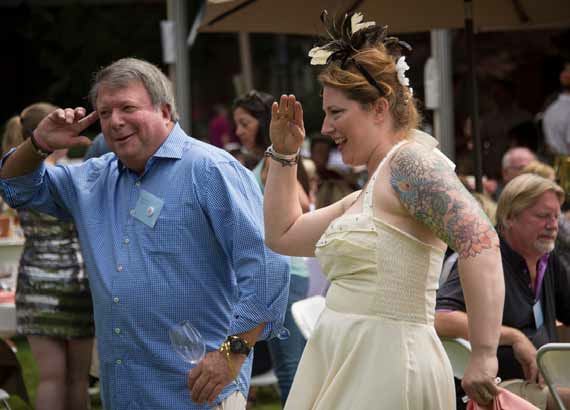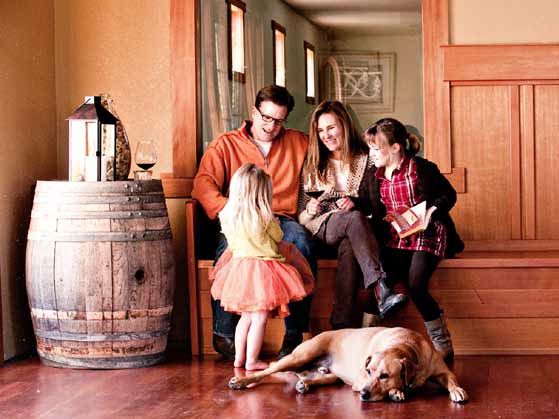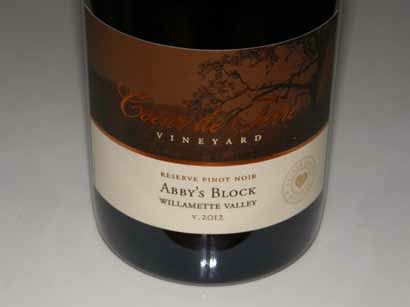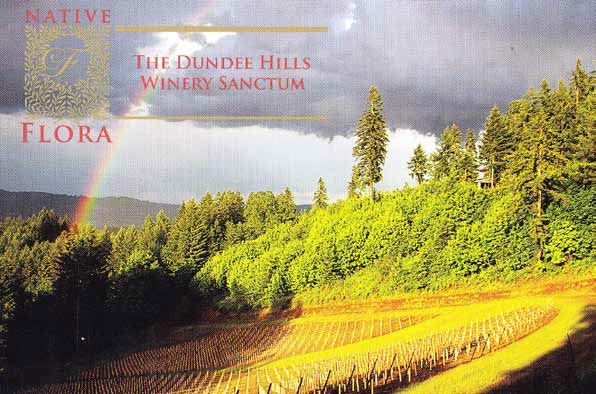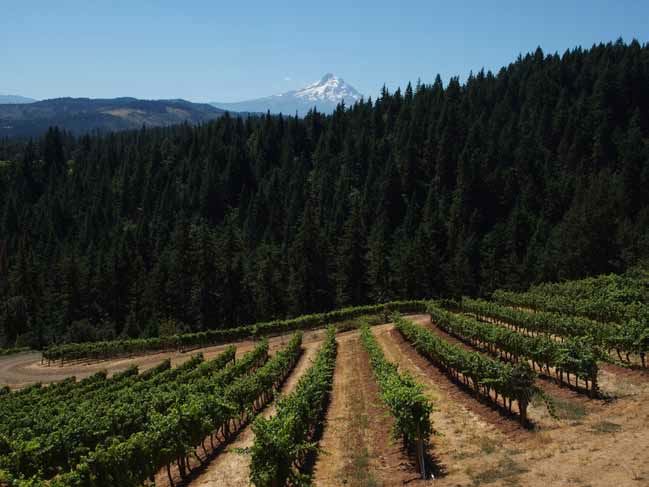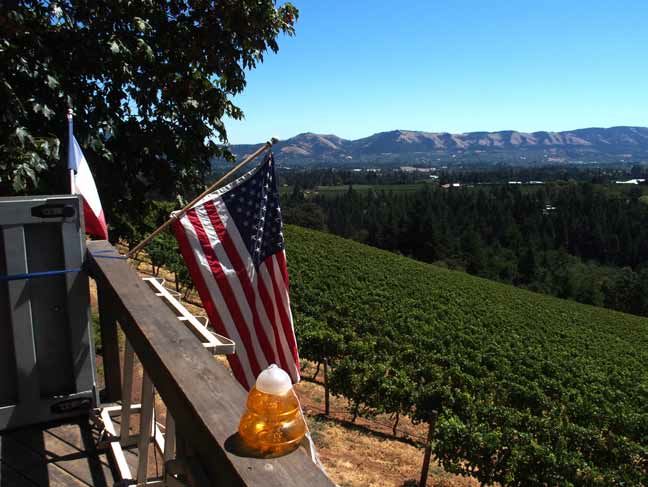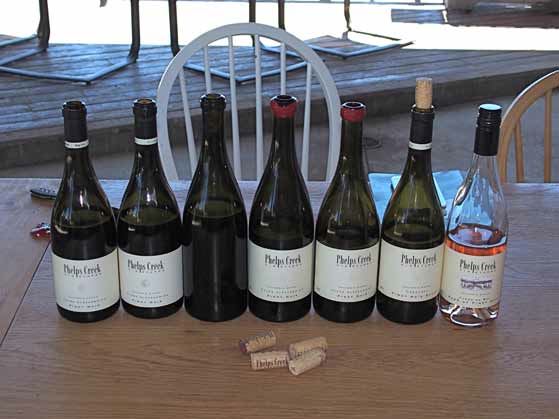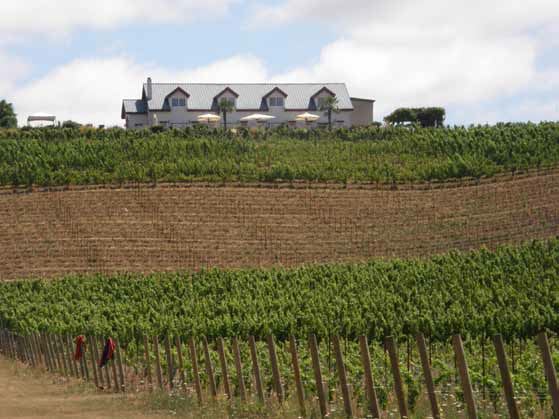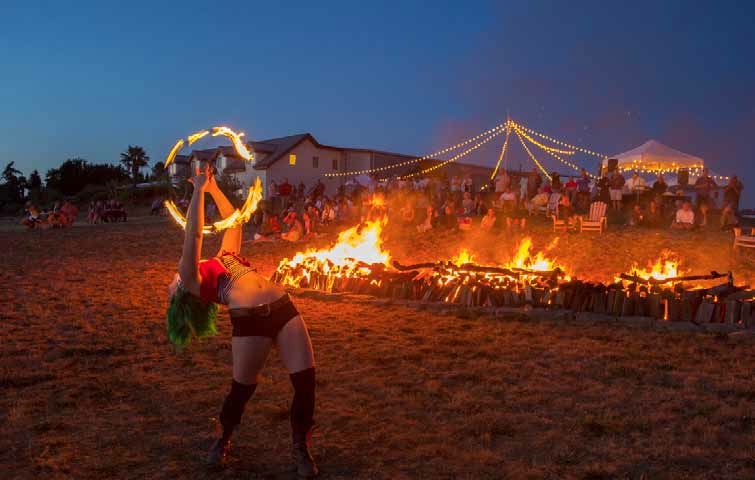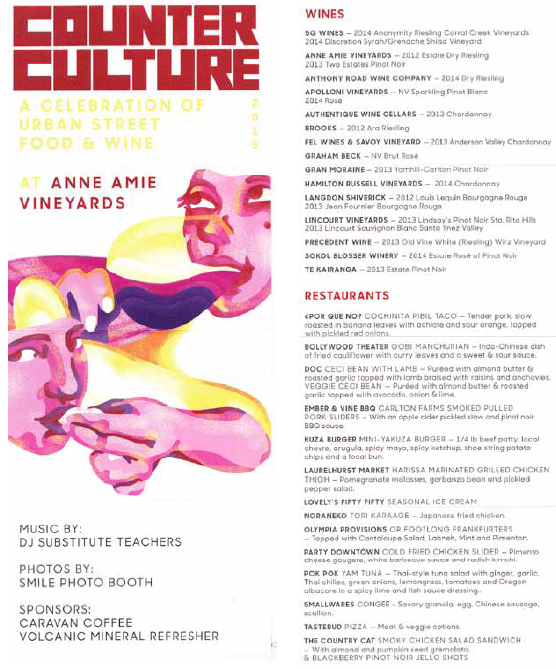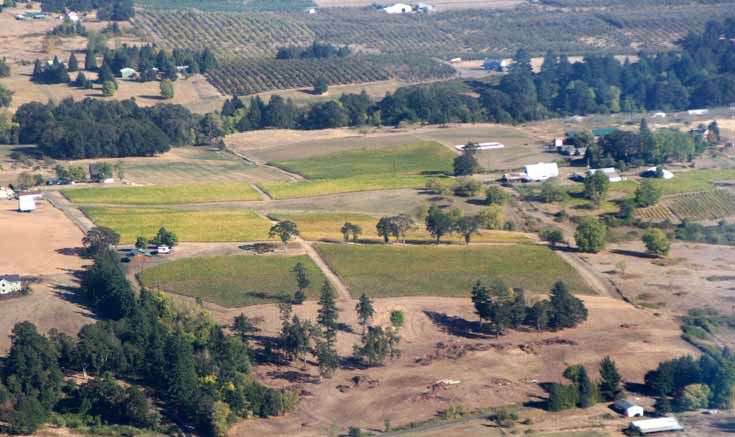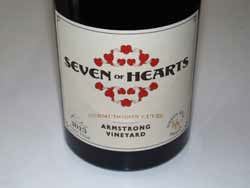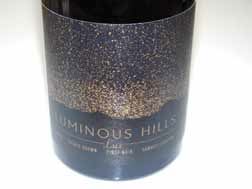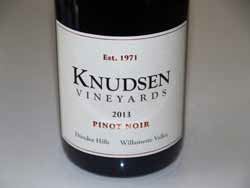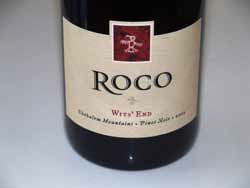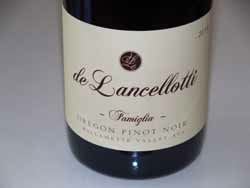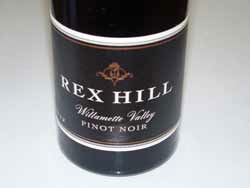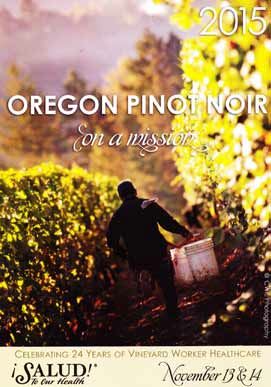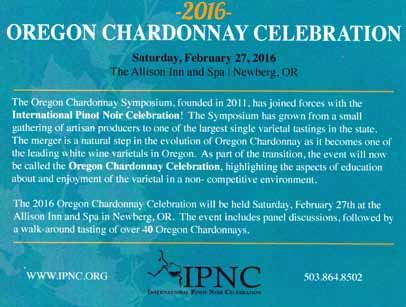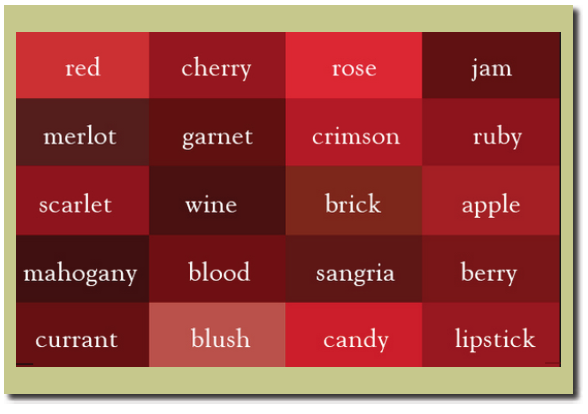PinotFile: 10.16 September 3, 2015
- 2015 International Pinot Noir Celebration: Pinotphiles Congregate to Worship a Grape
- Four Off-the-Beaten Track Oregon Wineries To Visit Now
- Tasting Latest Releases at Anne Amie Vineyards
- Lachini Vineyards Offers Pinot Noir Worth Coveting
- Small Sips of Recently Tasted Premium Oregon Pinot Noir
- Small Sips of Recently Tasted Willamette Valley AVA Pinot Noir
- Oregon Pinot Briefs
- Assigning Color to Pinot Noir is a Challenging Job
|
2015 International Pinot Noir Celebration: Pinotphiles Congregate to Worship a Grape
Each summer around the third weekend in July, nearly 1,000 pinioristes from around the world travel to the
small township of McMinnville in the Willamette Valley of Oregon, steadfast in their devotion to Pinot
Noir that that is considered more of a religion than a grape. Like any religion, parishioners gather as a single
community to honor the supreme grape with rituals, sermons, feasts and festivities.
The Church of Pinot Noir has a sacred history, now 50 years old in the Willamette Valley and centuries old in
Burgundy, France. Members who join the Church of Pinot Noir, also known as Pinotholicism, usually enter into
worship after an epiphany with Pinot Noir. Followers offer a significant percentage of their monthly income to
the high priests of Pinot Noir such as Lalou Bize-Leroy, Christophe Roumier, Dominique Lafon, Ted Lemon,
Tom Rochioli, Michael Browne, Ken Wright, Jason Lett and Steve Doerner.
During the three-day 29th Annual International Pinot Noir Celebration (IPNC), held this year on July 24-26, 2015,
attendees congregated over multiple bottles of Pinot Noir to smell, taste and give thanks to the holy grape. This year’s
invited priest, who served as Master of Ceremonies, was noted actor Sam Neill of Two Paddocks Winery in New
Zealand. He captivated the audience with his discussion of the Church of Pinot Noir, emphasizing that devotion
to Pinot Noir, like any religious involvement, is associated with better health, a valuable sense of humor, and
greater longevity.
The IPNC offers the opportunity to sample hundreds of Pinot Noirs over three days. It is the one time of the year when you can ignore the advice of your doctor who told you, "One drink a day, not drink all day."
About 800 registered guests attended the 2015 IPNC weekend, including over 140 representatives from the 74
featured wineries. Additional consumers were included in the Saturday night Salmon Bake, all on a mission to
experience an Pinot Noir epiphany. Approximately 550 guests also attended the IPNC’s Sunday Passport to
Pinot at the end of the weekend. Since the first IPNC in 1987, the festival has brought over 15,000 Pinot Noir
devotees from around the world to McMinnville. Each year, many sommeliers and 50 noted Pacific Northwest
chefs also volunteer to make the IPNC successful.
Featured producers are chosen for their devotion to Pinot Noir, and included wineries from Australia, Burgundy,
California, Canada, Champagne, Italy, New Zealand, Oregon and South Africa. Since 1987, the IPNC has
hosted a total of 307 foreign wineries.
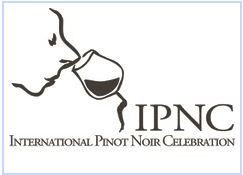
The following pages will take the reader on an exploratory trip of this year’s IPNC. Noted photographer, Andrea
Johnson, supplied a number of photos to supplement my own photos. I have a rare photo below in which
Andrea is in the photo rather than behind the camera (that’s her in the blue dress on the far left, but where is
her Pinot glass?). Her website is www.andreajohnson.com. After reading this, you will surely take on the urge
to join the congregation and attend next year’s event yourself. The 30th Annual IPNC will be held July 29-31,
2016 at Linfield College in McMinnville, Oregon. If you would like to be added to the IPNC mailing list and
receive the IPNC e-newsletter, the IPNC Seasonal Post, contact IPNC by phone (503-472-8964 or
800-775-4762), email (info@ipnc.org) or consult the official website at www.ipnc.org. The “Early Bird Special
offers $100 savings through December 31, 2015. The full weekend of activities is only $1,095.00 (by check).
Those with specific questions or winery participation inquiries may contact Executive Director Amy Wesselman
at 503-472-8964 or amy@ipnc.og.
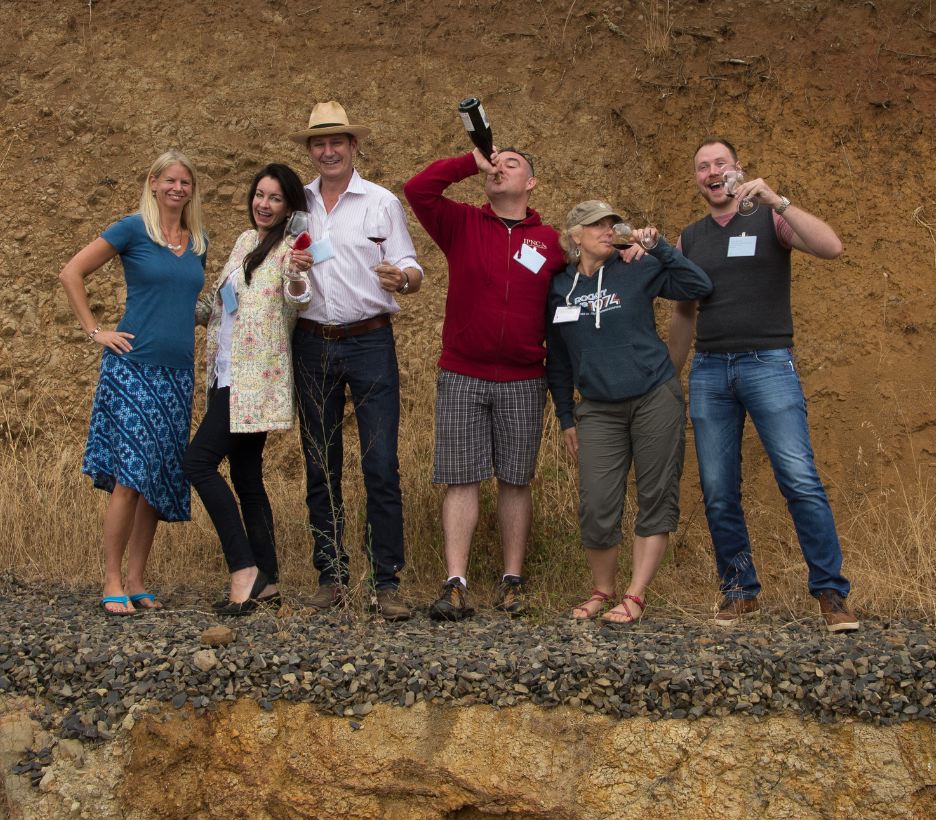
Opening Ceremonies
Sam Neill’s humor and charisma were on full display during his opening comments. Many know him for his
leading roles in ‘Jurassic Park,’ ‘The Piano’ and ‘Dean Spanley,’ but he is also well-known for the internationally-
awarded Pinot Noir grown and crafted at his Central Otago winery, Two Paddocks. Two Paddocks is a small
family winery started in 1993 with modest ambitions and 5 acres of Pinot Noir in Gibbston, Central Otago. A
friend, Roger Donaldson, planted the land next door, hence the name Two Paddocks. The original vineyard
has now been augmented by two other small, superbly sited vineyards, and Redbank, a 130-acre farm nestled
between two dramatic rocky escarpments. Neill said, “We hope and trust that you will enjoy Two Paddocks
wine, as much as we enjoy making it. We certainly enjoy drinking it, which makes it a little scarcer than perhaps
it might be otherwise.”

The introduction of all winery participants followed. See how many of the following American winemakers you
can name (answers below). Hint: Californians like their sunglasses.
Answers:
1 Michael Fay, Goldeneye
2 Theresa Heredia, Gary Farrell Vineyards & Winery
3 Adam Campbell, Elk Cove Vineyards
4 Ryan Hodgins, FEL Wines
5 Brian O’Donnell, Belle Pente Vineyard & Winery
6 Jason Lett, The Eyrie Vineyards
7 Tony Soter, Soter Vineyards
8 Rollin Soles, ROCO Winery
Other invited wineries from California included Bien Nacido Estate, Cartograph, Champ de Rêves Vineyards,
Crossbarn Winery, Davis Bynum, Domaine de la Côte, Hanzell Vineyards, J Vineyards & Winery, Lincourt
Vineyards, Tyler Winery, Walt Wines, and Wayfarer. Other invited wineries from Oregon included: Adelsheim
Vineyard, Amalie Robert Estate, Analemma Wines, Antica Terra, Argyle Winery, Beaux Frères, Bethel Heights
Vineyard, Big Table Farm, Boedecker Cellars, Coelho Winery, Coeur De Terre Vineyard, Crowley Wines,
Dancin Vineyards, Domaine Drouhin Oregon, Evesham Wood Winery, Goodfellow Family Cellars, Grochau
Cellars, Kelley Fox Wines, Lemelson Vineyards, Love & Squalor, Luminous Hills, Lumos Wine Co., Montinore
Estate, Penner-Ash Wine Cellars, Ponzi Vineyards, Tyee Wine Cellars, Wildaire, Willakenzie Estate and
Willamette Valley Vineyards.
The Grand Seminar
Tasting the Stars: Champagne & Sparkling Wine
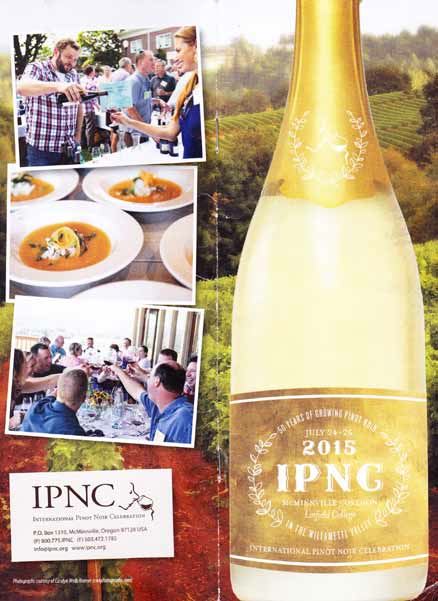
To mark the 50th anniversary of the first planting of Pinot Noir in the Willamette Valley by David Lett, it was only
fitting to celebrate with a Grand Seminar dedicated to exploring Champagne and sparkling wine. Moderated by
Patrick Comiskey, senior correspondent for Wine & Spirits magazine, the seminar offered specially selected samples of
Champagne and sparkling wine were offered to learn how bubbles get in the bottle, how “base” wines taste and
are evaluated, and how dosage affects the finished product. Presenters were Scott Anderson (J Vineyards &
Winery), Claude Giraud (Champagne Henri Giraud), Bryan Maletis (Fat Cork - direct sales of French grower
Champagnes), Thomas Pastuszak (The NoMad - Food & Wine “Sommeliers of the Year” of 2015), Michael
Quinttus (VINTUS - Distributor of Champagne Ayala and Domaine Chanson in Burgundy, both owned by
Bollinger family), Rollin Soles (ROCO Winery and co-founder of Argyle Winery), Tony Soter (Soter Vineyards -
producer of sparkling wine since 1997), and Rajeev Vaida (New York restaurant DANIEL - noted sommelier).
My “takeaways” from the Grand Seminar:
** Decision when to pick is critical to success of sparkling wine. For Pinot Noir, flavors will progress as follows:
green apple→ripe red apple→plum→strawberry→cherry→spice. Ideally, Pinot Noir grapes should be
harvested when at the ripe apple stage. For Chardonnay, the flavor sequence as ripeness progresses is as follows:
green apple→ripe apple→pear→honeysuckle. Ideally, Chardonnay grapes should be harvested at the green apple
stage.
** Dosage is addition of reserve (cave) wine and very pure cane sugar after disgorging. Wines with four levels
of dosage were offered for tasting: 0 grams/liter, 3 grams/liter, 8 grams/liter and 13 grams/
liter of residual sugars. I preferred 3 grams/liter, but the group as a whole liked 8 grams/liter best. 3 grams/liter would be an
Extra-Brut style, while 8 grams/liter would be a Brut style. Dosage was humorously described as “hamburger
helper for Champagne.”
** I was surprised to learn there are 84,000 acres of vineyards in Champagne, but 19,000 growers. About
5,000 growers produce wine from their own grapes (Grower Champagne).
** Grand Marque Champagnes have a house style, while Grower Champagnes (made by the same estate that
owns the vineyards) are more individualistic and terroir focused. One is not necessarily better than the other,
just different. Grower Champagne is identified by the initials “RM” (meaning Récoltant-Manipulant) on the wine
label.
The final sparkling wine offered for tasting was a special wine produced by Jason Lett to mark the 50th
Anniversary of The Eyrie Vineyards. It was produced from Pinot Meunier grapes planted in the Dundee Hills by
David Lett in 1965 and 1979. After basket pressing, the Pinot Meunier from the old vines was fermented and
aged in neutral French oak barrels for up to 3 years. This Brut Nature style of sparkling wine was vinfied by the
méthode champenoise, and underwent zero dosage after disgorging on January 14, 2015.
Lunch on the Lawn
On the first two days of the IPNC (Friday and Saturday), the attendees are divided into two groups with one
group attending the Grand Seminar, followed by Lunch on the Lawn, and then participation in a choice of a
wide variety of informative seminars known as the University of Pinot. The other group is bused to various
wineries in the Willamette Valley for a vineyard tour, seminar and lunch, returning to campus later in the
afternoon for University of Pinot. The activities for each group are reversed on the following day.
At the Lunch on the Lawn, a winemaker is present at each table which leads to lively discussions of Pinot and other far-ranging subjects. Think of it as getting to know winemakers up close and personal. Multiple wines are offered throughout lunch by a talented crew of sommeliers, including
special wines brought to each table by the hosting winemaker. I was seated with Ray Walsh who makes wine
in both Marlborough, New Zealand and the Willamette Valley under the Capitello Wines label.
Ray began his study of enology in New Zealand and soon was making wine for Villa Maria and then Coopers
Creek. He was recruited as cellar master for King Estate in Oregon, and in 1999, was named winemaker. Ray
launched his own artisan brand, Capitello Wines, in 2003. He settled in Eugene, Oregon, where he crafts the
Capitello wines and has a tasting room. Each spring he heads to New Zealand to work harvest and produce
additional wines from the Marlborough region. He says, “I learned about grape growing in New Zealand, and I
learned about winemaking here in Oregon, so I feel really blessed to be able to produce wines from each
distinctive region to showcase the stark contrasts of terroir from opposite ends of the world.”
The 2008 Capitello Willamette Valley Pinot Noir was very appealing with a very seductive soft texture and
elegant demeanor. The 2012 Capitello Succession Cuvée Willamette Valley Pinot Noir was also offered at
lunch. This is a limited production wine fermented in an oak tank. It was an incredibly expressive wine that
really impressed me. It is available only to wine club members and is reason enough to sign up for the winery's wine club. Visit
www.capitellowines.com.
The guest chefs and the menu for the Lunch on the Lawn:
University of Pinot
The course I took was “Pinot Noir 101 - Sensory Science” moderated by sommeliers Thomas Pastuszak and
Rajeev Vaidya.
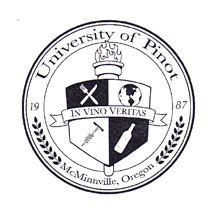
6 wines were tasted blind and were presented for discussion. The sommeliers offered their descriptions of the
wines which were then compared with the descriptors of the audience. I can’t say I learned any new information to
pass along although I enjoyed the wines: 2012 The Eyrie Vineyards Three Sisters Vineyard Dundee Hills
Pinot Noir (aromas of cherry, raspberry, herbs and oak and lighter-weight flavors of black raspberry and herbs
framed by good acidity and soft tannins, finishing with a touch of alcoholic warmth); 2011 Domaine Drouhin
Laurene Dundee Hills Pinot Noir (very shy initially, showing more fruit on the nose over time, with mid weight
flavors of dark red cherries and berries offering good intensity and some finishing length); 2011 Domaine de la
Côte Sta. Rita Hills Pinot Noir (very savory due to whole cluster with aromas of briar and pine sap, and flavors
of wood-kissed purple fruits); 2009 Tyler Bien Nacido Old Vine Santa Maria Valley Pinot Noir (very aromatic
with scents of plum and spice, leading to an expressive, sweet dark fruit core with a hint of dark chocolate,
finishing smooth and slightly shallow); 2008 Hanzell Sonoma Valley Pinot Noir (my favorite in the lineup with
inviting aromas of black cherry, black raspberry and spice, backed by oak-kissed black cherry flavor framed by
substantial but not imposing tannins, finishing very smooth and satisfying); 2007 Mt. Difficulty Central Otago
New Zealand Pinot Noir (the nose led with purple fruits and plenty of smoky oak, followed by a woody, earthy
and tannic palate that had lost freshness, and showed little fruit expression).
** Tar and other oak-driven characters replace more desirable fruit-driven characters in Pinot Noir. A tiny bit is
acceptable and even desirable to some drinkers, but very unpleasant if it dominates.
A couple of takeaways:
** Pinot Noirs that make you salivate have more acidity, while those that are more mellow and smooth have
less acidity.
** Tasting Pinot Noir after opening a day or two later is valuable. If the wine is better, it tells you it has
somewhere to go. If worse, the wine will be short-lived, and perhaps to be avoided.
Alfresco Tastings
These walk-around tastings are held Friday and Saturday afternoon under the trees on The Dormitory Quad
from 5:00-7:00 p.m.. These are joyous times when the winemakers are available for spirited discussion and
commentary. The photos below are of Erin Nuccio of Evesham Wood (Eola-Amity Hills) and of Brian Marcy and
Clare Carver of Big Table Farm (Yamhill-Carlton), two of my favorite Willamette Valley wineries.
With so many wineries pouring, it was impossible to taste them all. 2012 vintage Pinot Noir wines were poured
on Friday and 2013 vintage Pinot Noir wines on Saturday. Here is a list of the wines that stood out for me.
Australia
2012 Eldridge Estate Mornington Peninsula Victoria Pinot Noir
California
2012 FEL Wines Savoy Vineyard Anderson Valley Pinot Noir
2013 Gary Farrell Vineyards & Winery Rochioli Vineyard Russian River Valley Pinot Noir
2012 Goldeneye Gowen Creek Vineyard Anderson Valley Pinot Noir
2012 Hanzell Vineyards Sonoma Valley Pinot Noir
2012 J Vineyards & Winery Russian River Valley Pinot Noir
2013 Wayfarer Vineyard Sonoma Coast Pinot Noir
France
2012 Domaine Chevrot Maranges 1er Cru “Croix Moines”
2013 Domaine Marc Roy Gevrey-Chambertain “Clos Prieur”
France (Champagne)
NV Champagne Billecart-Salmon Brut Rosé Champagne
2004 Champagne Bollinger La Grande Année Brut Champagne
Italy
2012 Castelfeder Riserva “Burgum Novum”
New Zealand
2013 Escarpment Martinborough New Zealand Pinot Noir
2012 Two Paddocks Central Otago New Zealand Pinot Noir
Oregon
2012 Amalie Robert Estate Wädenswil Clone Willamette Valley Pinot Noir
2012 Antica Terra Antikythera Eola-Amity Hills Willamette Valley Pinot Noir
2012 Bethel Heights Vineyard Aeolian Eola-Amity Hills Willamette Valley Pinot Noir
2012 Big Table Farm Pelos-Sandberg Vineyard Eola-Amity Hills Willamette Valley Pinot Noir
2012 Coeur De Terre Vineyard Abby’s Block Reserve McMinnville Willamette Valley Pinot Noir
2012 Crowley Wines La Colina Vineyard Dundee Hills Willamette Valley Pinot Noir
2012 Dancin Vineyards “Trata” Southern Oregon Pinot Noir
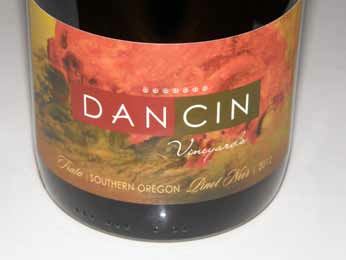
2012 Evesham Wood Le Puits Sec Eola-Amity Hills Willamette Valley Pinot Noir
2012 Love & Squalor Antsy Pants Willamette Valley Pinot Noir
2013 Luminous Hills Estate “Astra” Yamhill-Carlton Willamette Valley Pinot Noir
2012 LUMOS Wine Co. Temperance Hill Vineyard Eola-Amity Hills Willamette Valley Pinot Noir
2012 Ponzi Vineyards Reserve Chehalem Mountains Willamette Valley Pinot Noir
2013 ROCO Winery Wit’s End Vineyard Chehalem Mountains Willamette Valley Pinot Noir
2013 Soter Vineyards Mineral Springs Ranch Yamhill-Carlton Willamette Valley Pinot Noir
2012 Wildaire Cellars Reserve Yamhill-Carlton Willamette Valley Pinot Noir
Oregon (Sparkling Wine)
2007 Argyle Winery Knudsen Vineyard Julie Lee’s Block Dundee Hills Willamette Valley Blanc de
Blancs Sparkling Wine
2011 Soter Vineyards Mineral Springs Yamhill-Carlton Willamette Valley Brut Rosé Sparkling Wine
The Grand Dinner
This dinner never fails to impress me. 800 people are served dinner al fresco on the Linfield College intramural
field under strings of lights, and the food is gourmet quality. Wines from the IPNC's library are liberally offered and winemakers who grace
every table bring wine as well. The menu and a photo of the venue are below. I was fortunate to sit at the table
where Sheila Nicholas of Anam Cara Cellars in the Chehalem Mountains and Celia and Ken Austin III,
proprietors of Rain Dance Vineyards in the Chehalem Mountains. Their wines soared to spectacular heights on
this beautiful evening, particularly complimenting the Basque lamb shank en croute. Sheila offered the 2012
Anam Cara Cellars Heather’s Vineyard Chehalem Mountains Pinot Noir ($66, 92) and the 2012 Anam
Cara Nicholas Estate Mark VII Chehalem Mountains Pinot Noir ($66, 94). The Austins brought their
inaugural release, the 2013 Rain Dance Vineyards Estate Chehalem Mountains Pinot Noir.
The Rain Dance Vineyards new tasting room is located inside Rain Dance Marketplace at 26355 NE Bell Rd.,
Newberg, OR. The vineyard is situated at 450 to 700 feet elevation and the 8 acres (eventually 23 acres) is
planted on Jory and Hazelair soils. With the 2014 vintage, the Rain Dance Pinot Noir grapes will be Salmon-
Safe Certified and LIVE Certified.
Vineyard Tour & Winery Lunch
Stoller Family Estate, Dundee Hills
On the day your group is scheduled to go on a vineyard tour and winery lunch, you are assigned a bus, not
knowing which winery you are going to visit or what people will be joining your group. I was lucky to got to
Stoller Family Estate, where Bill and LaRue Stoller, winemaker Melissa Burr (pictured below at the seminar),
and vineyard manager Rob Schultz were are gracious hosts.
The seminar, “Which Clone Is It Anyway?” proved to be challenging. The group was given four single clone
2014 vintage barrel samples from Stoller Family Estate to taste blind. A score sheet listed some characteristics
which each person was asked to rate from 0 (do not perceive the characteristic) to 5 (strongly perceive the
characteristic). The 4 clones were 667, 777, Wädenswil and Pommard. It is extremely hard to identify the
clones as clonal expression varies greatly with different regions, specific sites within those regions and
vintages. Winemaking, of course, contributes as well. I only identified one clone correctly and I believe that
winemaker Melissa Burr and only one other member of the group of 40 correctly picked out each clone.
The message to take away from this exercise was that wines based on a single clone to do have some
commonality but site and vintage are more important than clonal type in determining the clonal expression.
One interesting fact came out of the discussion: there are more Pinot Noir clones than all varietal clones
combined! Pinot Noir is a promiscuous grape!
Vineyard tours and winery luncheons were held at numerous wineries throughout the Willamette Valley.
Pictured below from top to bottom are the vineyard tour and seminar at Anne Amie Vineyards and the seminar
at Penner-Ash Wine Cellars.
A wine country lunch followed the clonal seminars at each winery. The lunch at Stoller Family Estate was
exceptional and served with Stoller wines. After lunch, everyone in the group took turns introducing
themselves, describing where they were from, talking about their Pinot Noir epiphany, and relating how many
IPNCs they had attended. One member of our group had attended all 29 IPNCs! The lunch menu is below:
Northwest Salmon Bake
The Northwest Salmon Bake is a long-standing Saturday night tradition at IPNC. It is the one event during the
IPNC weekend that the public is allowed to attend, swelling the number of ravenous pinotphiles to well over a
1,000 strong, all congregating under the stars in the Linfield College lantern-lit Oak Grove. Everyone brings out
their good “stuff,” that is, special Pinot Noirs, many in large formats, meant to be shared among all in
attendance. Think of it as a Pinot Noir bacchanal.
The Northwest Salmon Bake features wild King salmon roasted on alder stakes over a large custom-built fire
pit. Along with the salmon, an extravagant buffet is offered which includes an extraordinary assortment of desserts.
The menu is below. After dinner, music brings couples together for dancing under the stars and more revelry.
Sparkling Brunch Finale
Plenty of good cheer pervades the morning after at this celebration finale featuring a sumptuous brunch paired with fine sparkling wines.
The sommeliers get crazy and don costumes that range from unusual to outrageous (see photos below).
One of the most enduring charms of IPNC is that when the attendees congregate to eat, they may find
themselves sitting next to a famous winemaker, a well-known wine critic, an iconic winery owner, or a notable
restaurateur. Sunday morning, I found myself sitting next to Bill Fuller, one of Oregon’s unsung pioneering
winemakers who established Tualatin Estate Vineyards near Forest Grove in 1973. You won’t find mention of
him in many current books on wine and Pinot Noir. I found him to be a fascinating study, willing to offer many
anecdotes of the early days of Oregon Pinot Noir. The following historical information was relayed to me by Bill
and additional information was obtained from www.enobytes.com.
William (Bill) Fuller
Bill and Virginia Fuller were part of the early 1970s wave of California immigrants who established vineyards in
the Willamette Valley after David Lett and Charles Coury, including among others, Dick and Kina Erath, Dick
and Nancy Ponzi, the Vuylsteke family, Arthur and Vivian Weber, Jim and Loie Maresh, Bill and Bessie
Archibald, Bill and Julia Wayne, Susan and Bill Sokol-Blosser, Dave and Ginny Adelsheim, Pat and Joe
Campbell, Jerry and Ann Preston, and Myron Redford. These pioneers found prospective vineyard land affordable for the going price for vineyard acreage in the Willamette
Valley in the early 1970s was about $1,500 per acre.
Bill, who studied chemistry in college, was teaching chemistry at Ukiah High School in California when he began doing lab
work for Italian Swiss Colony Winery. He met Louis Martini, who hired him as a winemaker if he agreed to take
classes at University of California at Davis. Bill got a Masters of Science degree in food technology,
specializing in enology. While at Davis, he met David Lett and Charles Coury.
Bill arrived in the Willamette Valley in 1971 after exploring vineyard sites with an investment banker. The two
partnered, bought 65 acres northwest of Forest Grove the same year. Tualatin Estate Vineyards was bonded
in 1973 and vines were planted. The first wines were made from Washington grapes, while the first estate wines were
released from the 1975 vintage. Tualatin Estate Vineyards was acquired by Willamette Valley Vineyards in
1997, and Bill became director of winemaking for McMenamin!s chain of restaurants and a winemaker for
Cooper Mountain Winery. He joined Willamette Valley Vineyards most recently as a winemaker.
Bill!s wines were among the best produced from the Willamette Valley through the years. His 1980 Pinot Noir
and 1981 Chardonnay won Double Gold and Best of Show trophies in a prestigious international wine
competition. His Chardonnay was the first Oregon wine to make the Wine Spectator Top 100 Wines.
A Vintage 40 Celebration with Bill Fuller will be held Saturday, September 12, 2015, at Tualatin Estate
Vineyard Tasting Room, 10850 SW Seavey Road, Forest Grove. Bill has joined the winemaking team at
Willamette Valley Vineyards to craft small lots of Pinot Noir and Chardonnay using his favorite vineyard blocks.
The 2013 Vintage 40 Pinot Noir and Chardonnay are being released on this occasion and will be available for
tasting as well as the 2014 futures. Pioneering stories from Bill are a bonus. The same evening, a Vintage 40
Wine Dinner featuring Bill Fuller will be held at the Tasting Room. Visit www.wvv.com/tualatin. Photo courtesy
of Oregon Wine History Archive, Linfield College.
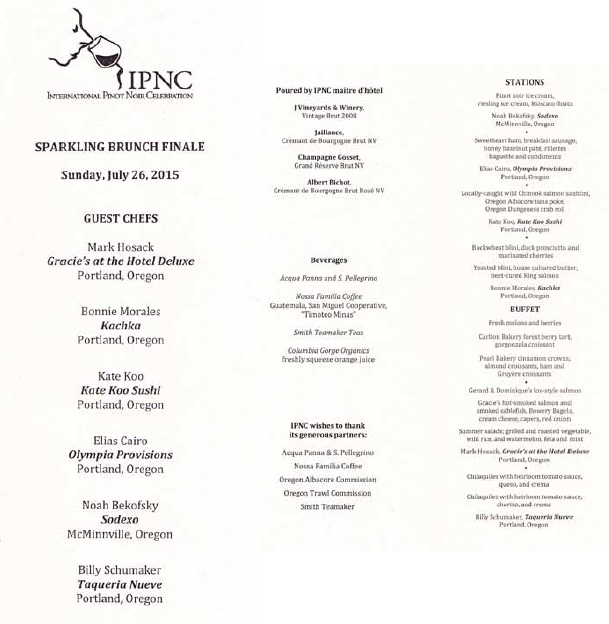
The weekend went by too fast and I was saddened to see it end. So much cheer and happiness and good
people delighting in a shared zeal for Pinot Noir. Many of those who attend are distant friends who I see only
once a year at this event which makes it extra special. In addition, I make many new friends each year among
readers of the PinotFile who introduce themselves. I also meet winemakers and winegrowers who
send me wines to review throughout the year. It is delightful to put a face to a wine! I met interesting people
such as Kenneth Olsen, a reader of mine from far away Denmark, and Ben Wolff of Owen Roe Oregon who generously gave me
a special bottle of Owen Roe Pinot Noir.
Whether you are a novice just developing an interest in Pinot Noir or a collector with an extensive library of
Pinot Noir wines, you must give yourself the gift of attending IPNC at least once. I can almost guarantee you
will be compelled to return repeatedly.
Four Off-the-Beaten Track Oregon Wineries To Visit Now
After attending this year’s IPNC, I visited four off-the-beaten track Oregon wineries that I highly recommend
you visit. These wineries are rather small and are located in areas that you need to make an effort to visit. That
said, your effort will be well worth it, as they all produce superb, even exceptional wines and you will be
welcomed graciously, especially if you tell the staff that I sent you.
Left Coast Cellars
Left Coast Cellars is located west of Salem, Oregon, in Rickreal on the 45th parallel. The 356-acre estate
seems vast, with several vineyards encompassing 130 acres facing west, north and south in an amphitheater
arrangement surrounding a large meadow and spring fed lake. The vineyards include the 14.6-acre The Bench,
planted in 2001 to Pinot Noir (777, 667 and 114), the 10.4-acre Latitude 45 also planted in 2001 (777, 667 and
114), the 12-acre Right Bank planted in 2001 to Pommard Clone of Pinot Noir, the 9.49-acre Left Bank planted
in 2003 to Chardonnay and Pinot Blanc, the 0.94-acre Syrah planted in 2005, the 13.78-acre Truffle Hill planted
in 2005 to Pinot Noir (Wädenswil and Pommard), the 7.4-acre The Orchards planted in 2005 to Pinot Gris, the
22-acre Field of Dreams planted to Pinot Blanc, Viognier, Chardonnay, Pinot Meunier, and Pinot Noir
(Pommard, “828,” and Wädenswil) in 2007 and 2008, and the 13.92 High Acres planted to Pinot Meunier and
Pinot Noir (777 and 667) in 2013. All vineyards are LIVE certified and Salmon Safe.
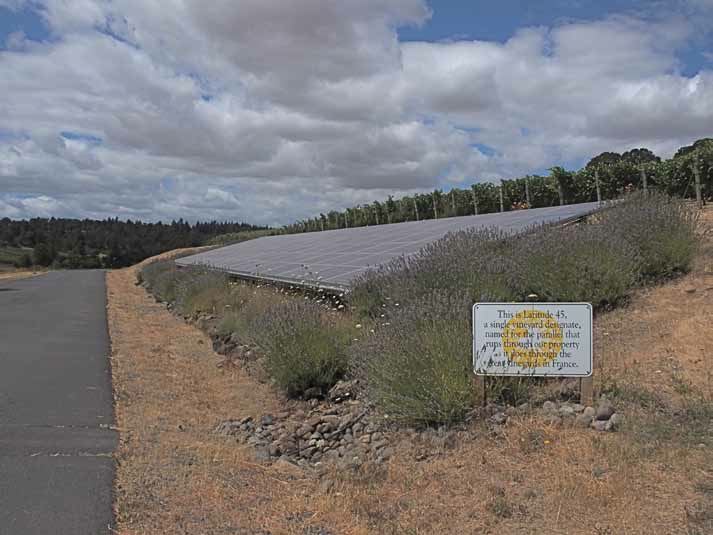
The vineyards are impressive, but it is the people that make this winery so inviting. The grounds are beautifully
maintained by master gardener Bob Pfaff, the bee hives that produce estate honey are maintained by Cali
Pfaff, the chef at the winery’s cafe is Carolynn Andringa, the founding winemaker and viticulturist is Luke
McCollom and the winemaker is Joe Wright. Joe has been a friend of mine for some time and he is one of the
nicest guys you will ever run into, as well as a consummate professional winemaker. He was all smiles as he
and his spouse adopted a newborn boy during the last harvest and lived to talk about it.
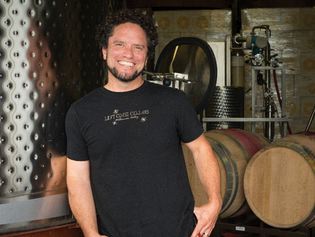
Joe is adept at both white and red wines and I have never tried a Left Coast Cellar wine that I didn’t like. White
wines include Pinot Gris, Chardonnay, Pinot Blanc, Pinot Noir Blanc (this white Pinot Noir is one of my favorites
currently offered in Oregon) and Viognier. The Pinot Noirs include Cali’s Cuvée, Latitude 45º, Right Bank,
Truffle Hill (this site is home to 4 acres of European Black Truffle-inoculated hazelnut trees), and Suzanne’s
Estate Reserve, ranging in price from $24 to $50. Winemaker’s selections are also offered to Wine Club
members.
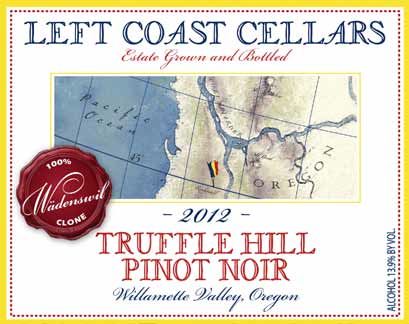
If you visit, allow plenty of time to relax in the tasting room (open daily during the summer) and sample the
wines, and then dine casually inside or outside overlooking the gardens, enjoying the winery’s Cafe cuisine that
pairs so well with Left Coast Cellars wines. On weekends, the wood-fired pizza oven is in operation. When I
visited, I had the duck egg salad sandwich made with duck eggs from ducks that live on the property and it was
the best egg salad sandwich I have ever eaten bar none!
Left Coast Cellars wines are sold through the tasting room, the winery’s wine clubs, and on the website at
www.leftcoastcellars.com. Current production is between 25,000 and 30,000 cases.
Coeur de Terre Vineyard
I have enjoyed Coeur de Terre Vineyard Pinot Noirs for several years and reviewed them in the PinotFile since
the 2008 vintage, but this year was my first visit to the estate in McMinnville. The estate vineyard and winery are located just a short drive south of the town
of McMinnville on Highway 18, but hidden back in the hills on Eagle Point Road. You have to make an effort to
visit, but it is well worth your time. Scott Neal and his staff were on hand to greet me and we tasted through a
number of wines.
Scott and Lisa Neal launched Coeur de Terre Vineyard with limited capital, a used tractor, and a vision of how
they would develop the 50-acre estate property. Launching a winery on a bootstrap is quite daunting, but
beginning in 1998, they were able to graft their own vines, develop their own vineyard, and build their own
winery, as well as expand to a 100-acre estate with adjacent land acquisition.
Over 80,000 vines were hand grafted at the estate’s nursery and have been the parent material for the
vineyard after the initial Renelle’s block planting. The vineyard was established from 1999 to 2007 and includes
several Pinot Noir clones including Dijon 115, 667, 777, Pommard, Wädenswil and field blend selections.
23 acres are now planted primarily to Pinot Noir in soils of both sedimentary and volcanic origin. The Neals are
dedicated to sustainable and organic viticultural practices.
The Neal's goal is to reveal the terroir of different portions of the estate vineyard. Four block-designated Pinot Noirs
are offered that speak to the earth of the various distinctive plots of the vineyard. Each block-designated Pinot
Noir is vinified identically to allow the land to speak.
The name, Coeur de Terre, is French for “Heart of the Earth,” and was inspired by a large heart-shaped rock
found during establishment of the estate vineyard.
Coeur de Terre was a featured winery at this year’s IPNC, and the wine poured was the 2012 Abby’s Block
Reserve Willamette Valley Pinot Noir.
The 2012 Coeur de Terre Vineyard Pinot Noirs were reviewed in December 2014. Now, 7 months later, I sat
down with Scott and re-tasted the wines.
2012 Coeur de Terre Vineyard McMinnville Willamette Valley Dry Riesling
$19. Sourced from Hyland
Vineyard in the McMinnville AVA, a cool, high elevation site with some of the oldest Riesling vines in Yamhill
County dating back 30 years. Aged 18 months in stainless steel.
·
Bone dry, with a good grip, but not imposing
acidity. Plenty of flavors including green apple, citrus, and peach. Highly enjoyable.
Score: 90
2013 Coeur de Terre Willamette Valley Pinot Noir
50% estate fruit and 50% sourced fruit. Intended for by
the glass restaurant programs.
·
Light violet-red color in the glass. Mid weight flavors of cherry, strawberry and
spice. Very forward and easy to drink with soft tannins and juicy acidity.
Score: 89
The Coeur de Terre tasting room is housed in a comfortable, barn-like structure adjacent the winery
overlooking the estate vineyard, and is open Thursday through Monday and other times by appointment. The
tasting room staff are extremely knowledgeable and gracious. The wines are sold online at
www.cdtvineyard.com.
Native Flora
Native Flora is a small, secluded vineyard and winery hidden high in the Dundee Hills on Warden Hill Road
which is home to several more high-profile wineries such as Winderlea, Arterberry Maresh at the Red Barn, and
Revana Family Vineyard. Founded in 2005 by Scott and Denise Flora, their estate sanctum features a winery,
tasting areas and home rolled into one surprising structure and endeavor. As Scott notes, “When you walk into
our tasting room, you have literally walked into our life.” The view from the tasting area is spectacular with a
180 degree vista overlooking Ribbon Ridge, Chehalem Mountains and Yamhill-Carlton appellations.
The estate consists of 33 acres with 15 acres under vine (Tuition Vineyard), including 9 clones of Pinot Noir
and some Pinot Blanc. The vineyard is perched at 800 feet elevation.
The winemakers are owner Scott Flora and Patrick Reuter. Reuter, who has been with Native Flora since 2009,
was educated at University of California at Davis, and gained winemaking experience in Burgundy, South
Africa, New Zealand, and California, and is the winemaker and co-owner of Dominio IV Wines.
The wines are driven by a preference for balance and acid-driven character. All Pinot Noirs are 100% de-stemmed
and generally aged in 15% to 18% new French oak barrels.
Scott and Denise welcomed me into their tranquil tasting room (although it was more like inviting me into their
home) and here are my tasting impressions of current releases:

2011 Native Flora Jolly Rancher Estate Dundee Hills Willamette Valley Rosé
180 cases,$26. This wine
was made specifically as a rosé. Co-fermented 50% Pinot Noir and 50% Pinot Blanc.
·
A very unusual
combination of grapes, this fresh, succulent wine, is crisp, dry, and refreshing, and features both white and red
stone fruits. It is still drinking as a youngster despite its 2011 vintage origins.
Score: 89
2012 Native Flora Venerable Youth Eola-Amity Hills Willamette Valley Pinot Noir
14.6% alc., 89 cases,
$44. Sourced from Sunset View Vineyards managed by Bob Bailey. Includes grapes from 20-year-old vines
and newly planted vines.
·
Enticing aromas and flavors of black cherry, blackberry and spice composed in an
elegant fashion with modest tannins and a generous burst of fruit goodness on the finish. The alcohol is nicely
integrated.
Score: 90
2012 Native Flora Jaguar Reserve Estate Dundee Hills Willamette Valley Pinot Noir
96 cases, $68 (sold
out). The pinnacle of estate Pinot Noir representing 4 barrels in this vintage. Primarily clone “828.” Aged in
100% French oak barrels, 25% new.
·
This beauty has plenty of fruit sap and a big, long finish, yet is light on its
feet with a lovely gentleness that is quite seductive. Plenty of cherry and berry flavor, with accents of cola and
spice.
Score: 92
2011 Native Flora Cuvée Lussier Estate Dundee Hills Willamette Valley Sparkling Wine
142 cases, $65.
7% to 8% Pinot Blanc added to Pinot Noir. 5 gm/L dosage. Sold exclusively in tasting room. Vinified by
méthode champenoise, two years en tirage.
·
A spectacular wine in every way, featuring a fine, persistent bead,
an array of luscious fruit flavors including pear and tropical fruits, and a dry, yeasty finish. A truly unique and
special wine that would be fitting for any special celebration or fine meal.
Score: 93
Intimate tastings are available by appointment only through the website at www.nativeflora.com or by phoning
503-504-1990. An attempt is made to accommodate visitors at short notice.
Phelps Creek Vineyards
In May 2015, I wrote a feature on Phelps Creek Vineyards (www.princeofpinot.com/article/1678/), so I will not
reiterate all the details here. This winery is unique among Oregon wineries in that the consulting winemaker,
Alexandrine Roy, is a Burgundian who crafts wines in Gevrey-Chambertain at her family’s estate, Domaine
Marc Roy, and since 2012 flies to Oregon three or four times a year to oversee the winemaking at the Phelps Creek estate
owned by Robert Morus that is located in Hood River, Oregon. She initially was tagged to produce a special
cuvée from the estate Pinot Noir vines (“Cuvée Alexandrine”), but her role expanded to include all wine
production.
I have known Alexandrine, a fourth generation vigneron, for several years as she attends IPNC every year and
World of Pinot Noir frequently. I greatly admire her Domaine Mark Roy wines, and have developed a fondness
for the Phelps Creek Vineyards wines as well. This photo was taken at this year’s IPNC by photographer
Robert Holmes (you will know him at IPNC and other wine events as a sidekick to photographer Andrea Johnson and by his upbeat smile and his weird
sense of deprecating humor).
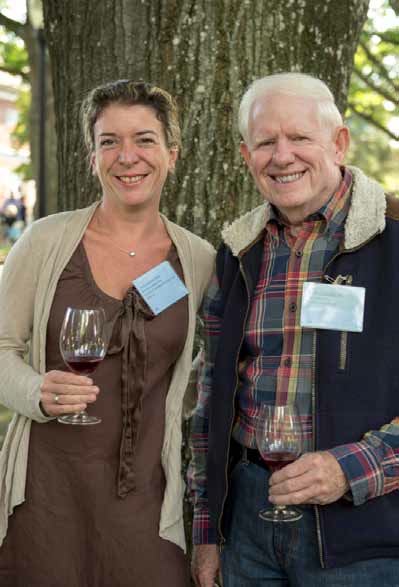
The one-hour drive east from Portland carried me along the scenic Columbia River to the Columbia Gorge
winegrowing region, and I was met at the Phelps Creek Vineyards tasting room located at the Hood River Golf
Course by Jon Wadman, the Regional Sales Manager. The road to the vineyards and winery is not for the faint
of heart, so Jon drove me up the circuitous, unpaved road in his well-traveled vehicle and I was welcomed by
several very gracious members of the Phelps Creek Vineyards team. I must say, this was one of the warmest
greetings I have ever experienced on a winery visit. Enologist Bill Swain and summer vineyard ambassadors
Jean-Luc LaCosse and Vanessa Banuelos spent a few hours with me as we talked wine and tasted through a
number of Phelps Creek Vineyards offerings including a vertical of Cuvée Alexandrine Pinot Noir. Alexandrine
had returned to Burgundy after this year’s IPNC, but the crew spoke with reverence about her talents.
Phelps Creek is not an architectural homage to wine, but has a rustic charm, and with its elevated 800 to 1,200
foot location, offers expansive views of the 32-acre vineyard below and Mt. Hood in the distance (see photo
below). What distinguishes the winery are the quality of the wines and the special people that make them.
The winery focuses on estate grown Pinot Noir and Chardonnay, as well as a superb Rosé and Pinot Noir
Blanc, producing about 5,000 cases annually. The Fleur de Roy Columbia Gorge Rosé is among the best
Oregon has to offer. No wonder the latest vintage sold out 5 weeks after release. The wine’s crisp, clean vibe and juicy flavors
of red cherry and watermelon were perfect with the lunch I devoured after tasting.
Both the French and United States flags fly at the estate (below).
The vertical tasting of Phelps Creek Vineyards Cuvée Alexandrine was a memorable experience. I was
particularly impressed by the fact that this wine was distinctly different in each vintage. I was told that
Alexandrine picks special rows in the estate vineyard for this cuvée, and subsequently puts the cuvée together
by tasting the barrels in the cellar, noting in her head the blend that will best offer an expression of that vintage.
She doesn’t take notes, arriving at a conceptual cuvée, and directs the winery crew on that basis. Truly, an
extraordinary talent!
The Cuvée Alexandrine wines are mainly Pommard clone, primarily de-stemmed and fermented with
indigenous yeasts.
2008 Phelps Creek Vineyards Cuvée Alexandrine Columbia Gorge Pinot Noir
13.5% alc..
·
Moderately light
cherry red color in the glass. Bolder, with more aromatic and flavor intensity than the 2007 vintage. Uplifting
scents of cherry, dried rose petal and spice. Highly flavorful, yet elegant, with a core of black cherry, cranberry
and Damsel plum fruits. The tannins are silky and the finish is noticeably long and generous.
Score: 92-93
2010 Phelps Creek Vineyards Cuvée Alexandrine Columbia Gorge Pinot Noir
Unlabeled bottle.
·
Moderate
reddish purple color in the glass. Shy, but pleasing aromas of cherry, raspberry and spice. More fruit-driven
and less evolved than the 2007 and 2008 vintages, with discreetly concentrated flavors of cherry and dark red
berries with a touch of wood spice, and a firm, but not intrusive tannic backbone.
Score: 90-91

2011 Phelps Creek Vineyards Cuvée Alexandrine Columbia Gorge Pinot Noir
13.8% alc..
·
Moderately light
reddish purple color in the glass. Gorgeous nose filled with bright aromas of black cherry, black raspberry,
spice and a hint of toasty oak. Very luscious considering 2011 was a very cool vintage, offering a plethora of
dark fruits framed by firm tannins that create a mild astringency on the finish. This wine has a long life ahead.
Score: 93-94

2012 Phelps Creek Vineyards Cuvée Alexandrine Columbia Gorge Pinot Noir
13.5% alc..
·
Moderate
reddish purple color in the glass. Very sexy nose replete with hi-tone aromas of purple berries and plum sauce.
Mid weight plus flavors of black raspberry, marionberry and spice. The most intensely sappy wine in the lineup
with a big mid palate attack and a dreamy finish of remarkable length. The oak is nicely integrated. The wine is
still young, with some unresolved tannins but the future is bright.
Score: 93-94
The 2013 vintage was not tasted on this occasion but was reviewed in May 2015:
2013 Phelps Creek Vineyards Cuvée Alexandrine Columbia Gorge Pinot Noir
13.5% alc., 244 cases, $54.
Pommard and Dijon 115 and 777. Harvest Brix 23.8º. Aged in 100% French oak barrels, 25% new.
·
Not tasted as part of vertical tasting at winery. Previous tasting revealed following comments. Moderately
light reddish purple color in the glass. An earthy, savory nose with hints of black cherry, BBQ sauce and oak.
Quite elegant on the palate with a deep black cherry flavor accented with dried herbs and anise-laced oak.
Very charming now, but not fully expressive, and more giving the following day from a previously opened and
re-corked bottle. Best to cellar a year or two. Do I dare say, “Burgundian?”
Score: 92-93
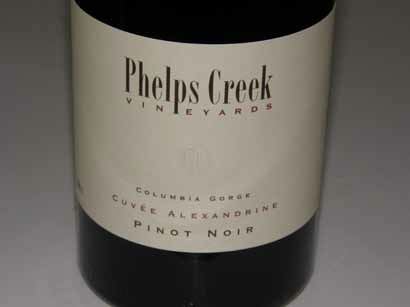
The Phelps Creek Vineyards tasting room at 1850 Country Club Road in Hood River is open daily from 11:00 p.m. to 5:00 p.m.. Bring a picnic lunch and sit on the patio. Tours of the vineyard and winery with seated
tastings are available by appointment. Visit www.phelpscreekvineyards.com.
Tasting Latest Releases at Anne Amie Vineyards
The day before IPNC I visited Anne Amie Vineyards and tasted the latest releases with winemaker Thomas
Houseman. Thomas is a colorful character who had a career early on as a modern dancer in New York where
he learned to make beer with the dance company’s lighting director. Sufficiently intrigued by fermentation and
its after products, he enrolled in the enology and viticulture program at University of California at Fresno. His
zeal for Pinot Noir led to winemaking stints at Husch Vineyards in the Anderson Valley, Bell Hill Winery in New
Zealand, and Ponzi Vineyards in the Willamette Valley.
Pinot Noir is produced primarily from two estate vineyards: Anne Amie Estate in the Yamhill-Carlton AVA on the
winery estate property, and Twelve Oaks Estate nearby in the Chehalem Mountains. A total of 120 acres is
planted, although not all is in production. Farming is all LIVE Certified Sustainable. The Anne Amie Estate
consists of 13.5 acres in production planted between 2001 and 2007 to Pommard and Dijon 115 clones in
Willakenzie soil.
Twelve Oaks Estate is in a cooler location than the Anne Amie Estate Vineyard and is divided into five smaller
vineyards or blocks. Plantings include Pinot Noir, Chardonnay, Pinot Blanc and Pinot Gris. This estate vineyard was
planted between 2000 and 2007 and includes Dijon 113, 114, 667, 777, “828,” Wädenswil and Pommard.
2013 was the last vintage that fruit was sourced and beginning with the 2014 vintage, all wines at Anne Amie
Vineyards will be made with estate fruit.
Anne Amie Vineyards wines include the entry level Cuvée A Wines, the Classic Wines and the Reserve Wines.
Only Classic and Reserve wines are reviewed here. All wines are bottled under screwcap closure.
Thomas told me that the 2012 vintage produced the most concentrated fruit ever. The warm but never hot
growing season (100+ days without rain) led to small, intensely flavored clusters (less than 50% of normal
size). The wines had so much structure that whole cluster was reigned in from the usual 5% to 20% amount
used during vinification. Thomas noted, “The dream vintage combination of a low natural crop load, a warm dry
summer, minimal disease pressure, and perfectly ripened fruit came true, with only one downside - there is not
enough wine.” My tasting impressions confirm that these are darkly colored, highly hedonistic, luscious and
densely fruited Pinot Noirs, yet they retain good vibrancy and balance.
The 2013 vintage was another story. Very early bud break and decent crop set was evident until a window of rain and cool
temperatures set in leading to uneven berry sizes in the clusters. The result was balanced crop loads of 1.5 to
2 tons per acre. Summer was warm and dry and optimism ran high until around September 11 when rain
showed up on the 10-day forecasts. By September 16, a typhoon was predicted. Grapes were picked before
and during an extended warm period after the downpour resulting in essentially three harvests: warm and early,
cool and damp, and warm and late.
2011 Anne Amie Marilyn Chehalem Mountains Brut Rosé
12.0% alc., pH 3.01, TA 0.83, RS .02%, 298
cases, $45. Released February 2015. 100% Twelve Oaks Estate. Production was by traditional méthode
champenoise, aged on the lees en tirage for 3 years, and a dosage added after disgorgement. Aged a further 4
months in bottle before release.
·
Pretty pink-orange color in the glass with a good bead. Aromas of blood
orange, peach and raspberry lead to a dry, crisp experience featuring flavors of blood orange, strawberry and
Damsel plum. The fruit intensity is discreetly concentrated and satisfying, and the wine sports a refreshing
finish than really cleanses the palate. I agree with Thomas regarding suggested food pairings: anything!
Score: 92
2012 Anne Amie Prismé Yamhill-Carlton Willamette Valley Pinot Noir Blanc
14.1% alc., pH 3.25, TA 0.56,
364 cases, $40. Released June 2015. 100% Anne Amie Estate. Barrel fermented in French oak puncheons,
lees stirring, 80% malolactic fermentation, and aged 16 months on its lees in 100% French oak barrels, 20%
new.
·
Light yellow color in the glass. Inviting perfume of fresh cut Gravenstein apple, vanilla cream and fig.
Slightly viscous on the palate, with a complex flavor profile featuring notes of apple, tropical citrus, pear and
pastry cream. The finish shows remarkable persistence for a white wine. A very unique, serious wine that is
one of the best examples of this white varietal.
Score: 92
2011 Anne Amie L’Iris Willamette Valley Pinot Noir
13.1% alc., $60. 15-20% whole cluster.
·
Moderately
light reddish purple color in the glass. The nose leads with aromas of cherry, smoke and piney oak. Very
elegant, and highly appealing on the palate in a mid weight style with plenty of fresh cranberry and black cherry
fruit flavor, and a compliment of spice. Soft tannins make for easy accessibility.
Score: 90-91

2012 Anne Amie Twelve Oaks Estate Boisseau Vineyard Chehalem Mountains Willamette Valley Pinot Noir
13.1% alc., pH 3.51, TA 0.62, 125 cases, $40. Released March 2015. From the
Brousseau block at Twelve Oaks Estate. At 750 feet elevation, Anne Amie’s highest elevation Pinot
Noir planting and a cool site that does best in warmer vintages. Pommard 4, 667 and 777 clones.
100% de-stemmed, 5-day cold soak, aged a total of 16 months in French oak barrels, 54.5% new,
and racked into neutral French oak barrels after 10 months. Bottled unfined and unfiltered and bottleaged
for 12 months before release.
·
Moderately dark reddish purple color in the glass. Lovely aromas
of fresh cherry, strawberry, spice and toasty oak. Vibrant and clean on entry with a core of black
cherry fruit that really makes a statement. Beautifully crafted with a seamless composure, finishing with
amazing generosity.
Score: 93-94
2012 Anne Amie Twelve Oaks Estate Louise Vineyard Chehalem Mountains Willamette Valley Pinot Noir
13.7% alc., pH 3.60, TA 0.61, 150 cases, $40. Released March 2015. Louis Vineyard is the lowest elevation
planting on the Twelve Oaks Estate making it a warmer site. Pommard 4 and Dijon 777 clones. Grapes were
de-stemmed, cold-soaked for 5 days, aged a total of 16 months in French oak barrels, 45.5% new, racked into
neutral French oak barrels after 10 months. Bottled unfined and unfiltered and bottle-aged for 12 months
before release.
·
Dark reddish purple color in the glass. Slightly brooding aromas of black raspberry, cassis,
underbrush, pine and spice. Bursting with luscious dark fruits, but somewhat reticent at this stage. A little more
tannin and more oak overlay compared to the Boisseau Vineyard bottling, but a similar well-endowed finish.
Score: 91-92
2012 Anne Amie Anne Amie Estate Yamhill-Carlton Willamette Valley Pinot Noir
13.7% alc., pH 3.57, TA
0.64, 150 cases, $40. Released March 2015. Clones are Pommard and Dijon 115. Aged 16 months in 100%
French oak barrels racked into neutral French oak barrels after 10 months), 16.6% new, 66.7% 1-year, and
16.7% neutral. Bottled unfined and unfiltered and bottle-aged for 12 months before release.
·
Deep, dark violet
color in the glass. Very restrained aromas of sous-bois, black cherry and blackberry lead to a full-bodied style
that is plush with purple and black fruits. The tannins are rather rugged and muscular at this stage, even
chewy, but are offset by a good vein of acidity. The long finish suggests potential with further cellaring.
Score: 90-91
2013 Anne Amie Willamette Valley Pinot Noir
4,000 cases, $28. Crafted in a different style than in previous
vintages (softer and more demure) and priced less. Softer and more demure. Aged 9 to10 months in barrel rather than 16 months as
in previous vintages.
·
Moderately light reddish purple color in the glass. A solid, forward-drinking wine with
pleasant cherry aroma and flavor framed by soft, supple tannins, finishing on a brisk and refreshing note.
Score: 88

2013 Anne Amie Winemaker’s Selection Willamette Valley Pinot Noir
13.5% alc., pH 3.57, TA 0.59, 2,435
cases, $28. Release October 2015. 37% Anne Amie Estate, 53.7% Twelve Oaks Estate and 9.3% Huntington
Hill. Multiple Dijon clones, Pommard 4 and Wädenswil 2A. Fruit was de-stemmed, an extended postfermentation
maceration, and aged on the lees in French oak barrels for 10 months, 14.8% new. Once bottled,
the wine was aged 6 months before release.
·
Moderately dark reddish purple color in the glass. The nose shyly
reveals aromas of darker fruits and cardamom spice with the slightest sweet oak. Luscious and opulent on the
palate, with a mid weight plus charge of black cherry and blackberry fruits nicely spiced and complimented by a
touch of anise-laced oak. Very enjoyable now.
Score: 89-90
2013 Anne Amie Two Estates Willamette Valley Pinot Noir
13.3% alc., 2,000 cases, $N/A. 68% Twelve
Oaks Estate and 32% Anne Amie Estate. About 20% whole cluster. Aged 16 months in French oak barrels,
30% new.
·
Moderately light reddish purple color in the glass. Nicely perfumed with effusive aromas of cherry,
rose petal and spice. More intensity, structure, and length than the Willamette Valley bottling, featuring inviting
flavors of cherry, raspberry and spice. Forward drinking, with invitingly juicy acidity making for a vibrant, fullflavored
wine.
Score: 90-91
A side note. On the Thursday evening before IPNC, a number of special dinners are held throughout the
Willamette Valley which are separate from the IPNC event but have become a tradition. This year I attended
the Counter Culture event at Anne Amie Vineyards which is a celebration of urban street food and wine. This is
a casual, walk-around affair on the winery’s property which offers entertainment as well as superb food and
wines from some of the participating wineries at this year’s IPNC. Photo below courtesy of Andrea Johnson
Photography
Lachini Vineyards Offers Pinot Noir Worth Coveting
This family owned winery was established in 1998 by Ronald and Marianne Lachini. The 45-acre (32.25 acres
planted to Pinot Noir and a small amount of Chardonnay), dry and biodynamically-farmed Lachini Estate
Vineyard is located in Newberg, Oregon, in the Chehalem Mountains AVA. Vineyard planting began in 1999
with 5 acres of Pinot Noir, with subsequent plantings from 2000 to 2007. In addition, the winery sources fruit
from a selected group of exceptional vineyards that share similar holistic farming practices.
The estate vineyard rises from 250 to 450 feet with south and southwest exposures and is composed of
distinct blocks identified by varying soil depths, and clones: East (Pommard), Middle (Dijon 113, 114, 115, 667
and 777), West (Wädenswil, “828,” 113, 777 and Pommard), and Lower West (113, 115, 777). Soils are
Willakenzie series (sandy, silty loam over broken basalt). Vineyard spacing is 4’ x 6’ on VSP trellis (roughly
1700 vines per acre).
Vineyard manager Ezequiel Arcos and winemakers Matthieu Gille and Ron Lachini work to produce Pinot Noirs
that have the structure and balance for both early and long-term enjoyment.. Current winemaking features
whole cluster and native fermentations and 100% French oak aging.
Since the first release in 2001, the Pinot Noirs have consistently rated 90 or above by many of the
major wine publications. Total case production is 4,500 to 5,600 cases per year that includes Chardonnay,
Cabernet Sauvignon (Walla Walla), Pinot Gris, Pinot Port and Muscat Canelli.
The winery and tasting room is located at 258 N. Kutch Street in Carlton, and a second tasting room is located
in Woodinville, Washington. The website is www.lachinivineyards.com. The wines are primarily sold through the
winery’s wine clubs, a mailing list, the tasting rooms and the web store.
The wines offered for review were all exceptional. In the 2013 vintage at the estate vineyard, a majority of the
fruit was harvested before the heavy September rains. The 2013 vintage in the Sonoma Coast was even with
little to no rain or heat spikes.
2013 Lachini Vineyards Lachini Family Estate Chehalem Mountains Oregon Pinot Noir
13.3% alc., pH
3.55, TA 0.73, 1,564 cases, $50. The winery’s signature blend of multiple clones including 667, 777, 113, 114,
115, Wädenswil and Pommard. Aged 17 months in 100% French oak barrels, 25% new and 75% 1 and 2-year-old.
·
Moderately light reddish purple color in the glass. A classic Oregon wine in character with fresh aromas of
cherry, cranberry and herbs in a forward-drinking style that aims to please. Mid weight flavors of wild
strawberry, cranberry and cherry are accented by notes of savory herbs. Nicely balanced
with a compliment of chocolaty oak in the background, modest fine-grain tannins, and some noticeable length on the
sweet scented finish.
Score: 92
2013 Lachini Vineyards La Cruz Vineyard Sonoma Coast California Pinot Noir
14.4% alc., pH 3.65, TA
0.60, 288 cases, $55. 40% 115, 40% Pommard, 10% 114 and 10% 123. Grapes were hauled in a refrigerated
truck for the long trip back to Oregon. 80% de-stemmed, 7 and 14-day cold soak in separate fermenters, native
yeast fermentations. Aged 14 months in 100% French oak barrels, 33% new 33% 1-year-old, and 33% 2-yearold.
·
Moderate reddish purple color in the glass. A plethora of black cherry and dark berry aromas and flavors
are featured in this middleweight wine that is not as vibrant as the 2013 Estate bottling, but has more sappy
fruit concentration. The tannins are modest, the texture is cozy, and the nutty oak in the background adds
interest. A rare example of California grapes vinified by an Oregon winery.
Score: 91

2012 Lachini Vineyards Cuvée Giselle Chehalem Mountains Oregon Pinot Noir
14.1% alc., pH
3.68, TA 0.545, 328 cases, $72. This is a selection of the finest 13 barrels from the Estate Vineyard
East, Middle and West blocks. Yields averaged 2.6 tons per acre. 40% Dijon clones, 30% Pommard
clone, and 15% Wädenswil clone with a small amount of “suitcase clone.” Unfined and unfiltered.
·
Moderately dark reddish purple color in the glass. Enchanting perfume of wild, dark berries, cherry pie
glaze, spices and a hint of white pepper. A stunning wine in every respect, with a well-ripened core of
black cherry and dark berry fruits. Very juicy and vivid with structured fine-grain tannins adding
support along with a compliment of tasty oak. A very intriguing wine that exhibits wonderful harmony. When
tasted later in the day from a previously opened bottle, I couldn’t get enough of this joyous juice. WOW!
Score: 95

2012 Lachini Vineyards PRIMA Lachini Estate Vineyard Chehalem Mountains Oregon Pinot Noir
14.2% alc., pH 3.55, TA 0.72, 75 cases, $100. Second vintage of this ultra premium Pinot Noir which
represents the finest expression of the Estate Vineyard’s terroir. This wine is only crafted in worthy
vintages. 3 barrels: 1 of Dijon 115, 1 of Dijon 114, and 1 of Pommard. Aged nearly 18 months. The
abbreviated crest on the special label indicates a dedication to the owners family’s heritage. The name
PRIMA means “FIRST” or “BEST.”
·
Moderately dark reddish purple color in the glass. The aromas leap
from the glass showing zeal and purpose with scents of marionberry, blackberry, cassis, tobacco and
Prada leather coat. Still a bit brooding and mysterious, but highly seductive, with a mid weight plus core of
luscious and juicy purple and black fruits. The fruit seems to burst on the mid palate, filling the mouth with
goodness. The wine’s tannins are well matched to the fruit load, and the resulting overall harmony is
impressive. One feature that really stands out is the suave and velvety mouthfeel. When tasted the following
day from a previously opened and re-corked bottle, the wine had become more open and expressive. Keep
this beauty in the cellar for another year or two at least for full enjoyment.
Score: 93-94
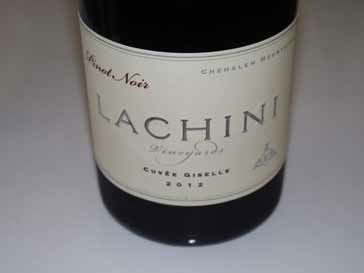
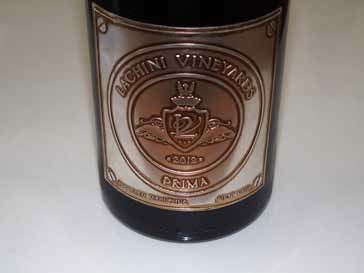
Small Sips of Recently Tasted Premium Oregon Pinot Noir

2013 Seven of Hearts Armstrong Vineyard Ribbon Ridge Willamette Valley Pinot Noir
13.1% alc., pH
3.51, TA 0.64, 98 cases, $35. A barrel selection from the lots produced from this vineyard. 50% Pommard plus
667, 114, 777 and Wädenswil grown in Willakenzie series sedimentary soil. 25% whole cluster fermentation.
Aged in 100% French oak barrels, 37.5% new.
·
Moderately light reddish purple color in the glass. Aromas of
cherry, strawberry, cranberry, and dried herbs. Light to mid weight array of red fruit flavors that are vivid with good
crispness. The tannins are suave, there is a faint touch of oak, and the finish is juicy and satisfying.
Score: 89
2013 Seven of Hearts Armstrong Vineyard Curmudgeon Cuvée Ribbon Ridge Willamette Valley Pinot Noir
12.9% alc., pH 3.53, TA
0.664, 25 cases, $42. A homage to the late Bob Wood who was a wine
lover that was the first to “discover“ Seven of Hearts. Clones 114, 667
and Pommard. 50% whole cluster fermented, aged in 100% neutral
French oak barrels.
·
Moderate light reddish purple color in the glass.
Very expressive nose, offering an appealing blend of cherry, crushed
strawberry, spice and toasty oak aromas. The light to mid weight flavors of
cherry and raspberry offer good mid palate intensity and length. Nicely
crafted, with a bright acid spine, pleasing oak in the background, and a
snappy finish.
Score: 90

2013 Seven of Hearts Bjornson Vineyard Eola-Amity Hills Willamette Valley Pinot Noir
12.9% alc., pH
3.56, TA 0.62, 73 cases, $35. Pommard and 777 clones grown in volcanic Jory and Nekia soils. Aged in 100%
French oak barrels, 17% new.
·
Moderately light reddish purple color in the glass. The nose reflects some whole
cluster with aromas of black cherry, wilted rose petal and spice box. Highly satisfying on the palate in a
smooth, sleek and easygoing style, with a flavorful black cherry core, a touch of oak and spice, and a silky
finish that urges another sip.
Score: 91

2013 Luminous Hills Estate Grown Yamhill-Carlton Willamette Valley Pinot Noir
12.5% alc., pH 3.57, TA
0.61, 347 cases, $35. The “silver label” Luminous Hills blend draws from the entire vineyard and includes 115,
667, 777 and Pommard. Aged in 100% French oak barrels, 25% new.
·
Light reddish purple color in the glass.
Rather savory on the nose, with aromas of wild strawberry and leaf. Modest in weight, but flavorful, with notes
of strawberry, cherry, red raspberry and Damsel plum. Light on its feet, with a lip-smacking, citrus-infused
finish.
Score: 89
2013 Luminous Hills Estate Grown Astra Yamhill-Carlton Willamette Valley Pinot Noir
12.7% alc., pH
3.58, TA 0.63, 98 cases, $42. Small production for the first time since 2009. Emphasizes 667 on Jory volcanic
soil and 115 on sedimentary soil. An expression of the eastern portion of the vineyard. Aged in 100% French
oak barrels, 25% new.
·
Light cherry red color in the glass. Pleasant perfume of fresh cherries, and dried rose
petal. Good mid palate attack of red fruit with sinew, accented with a riff of spice and oak. The tannins and
acidity are nicely folded in, and the red cherry-fueled finish is delightful. Tasted the following day from a
previously opened and re-corked bottle, the aromatics were still bright and the juicy red fruit driven flavors
appealing. This wine has the balance to age beautifully.
Score: 90
2013 Luminous Hills Estate Grown LUX Yamhill-Carlton Willamette Valley Pinot Noir
12.7% alc., pH 3.58, TA 0.62, 147 cases, $42. Select
lots of Pommard and 777. Aged in 100% French oak barrels, 33% new.
·
Light cherry red color in the glass. Bright aromas of red cherry, brown
spice and sandalwood. Similar to Astra, but with a little more fruit
intensity and spice pleasure. Nicely balanced, with flavors of black
cherry, cranberry and root beer framed by a vigorous tannic backbone
and a brisk cut of acidity. Still very enjoyable the following day from a
previously opened and re-corked bottle.
Score: 91
Where two prices are given for the following wines, the first price is the full winery retail price and the second
price is a reduced price I have seen offered by some retailers in Southern California.
2013 Beaux Frères The Beaux Frères Vineyard Ribbon Ridge Willamette Valley Pinot Noir
$90 ($81). 24-
acre, tightly spaced vineyard planted by Mike and Jackie Etzel from 1987 to 1991. Vineyard is farmed
biodynamically. Unfined and unfiltered.
·
Moderately light reddish purple color in the glass. The nose is more
savory than fruity sporting aromas of sous-bois, rose and cherry. Rather simple but easy to drink, with mid
weight flavors of red and black cherry, Asian 5-spice and a noticeable smoky oak overlay. Definitely better
when tasted the following day from a previously opened and re-corked bottle, when the fruit had gathered more
intensity and the oak had receded in prominence. Best to cellar this one a few years.
Score: 89-90
2012 Coelho Winery Paciência Estate Willamette Valley Pinot Noir
12.59% alc., $45.
·
Moderate reddish
purple color in the glass. The nose suggests some whole cluster with aromas of crushed cherries, exotic spices
and rose petal. Caressing in the mouth, with juicy flavors of black cherry, plum, black raspberry and spice in a
mid weight style. The fruit really grabs onto to the finish which has impressive length.
Score: 90
2013 Knudsen Vineyards Dundee Hills Willamette Valley Pinot Noir
13.5% alc., 200 cases, $55. A blend of grapes from three different blocks
including clones 777 and Pommard. One of Willamette Valley’s oldest
vineyards, established in 1971.
·
Light reddish purple color in the glass.
This wine has one of those noses you want to go on sniffing, featuring
cherry, cranberry relish, graham and sous-bois. The cherry flavor bursts
on the palate, caresses the mouth, and persists on the finish. A touch of
red strawberry and spice box adds interest. A cozy wine with modest
tannins, a juicy grip, and a crisp finish filled with bombastic cherry
goodwill.
Score: 93
2013 Ken Wright Cellars Abbott Claim Vineyard Yamhill-Carlton Willamette Valley Pinot Noir
12.5% alc.,
$45. Vineyard owned by Antony and Angela Beck. Vineyard manager Mark Gould. Marine sedimentary soil.
·
Light reddish purple color in the glass. Aromas of red cherry, dried red rose petal and fern leaf. Light to mid
weight flavors of red cherry with a hint of red hots and a bit of earthy flora and nutty oak. Flavorful, with nice
balance and some finishing intensity. Very good without being special.
Score: 89

2012 Patton Valley Vineyard The Estate Willamette Valley Pinot Noir
14.0% alc., $38 ($32), screwcap.
Winery’s flagship wine. Native yeast fermentation, small lot basket pressing. Unfined and unfiltered.
·
Moderately
dark reddish purple hue in the glass. This wine offers a riper fruit profile with aromas and flavors of
boysenberry, blackberry and cassis. Mid weight plus in style with modest, integrated tannins, and a
complimentary note of sweet oak. Well-endowed, but streamlined, with enough acidity to keep the wine
vibrant, finishing with a plethora of dark fruited goodness.
Score: 92

2012 ROCO Wit’s End Vineyard Chehalem Mountains Willamette Valley Pinot Noir
14.0% alc., 250 cases, $60
($45). Dijon clones planted in sedimentary soil. Estate grown
and vinified by Rollin Soles. 100% de-stemmed, 5-day cold
soak, house-cultured indigenous yeast, post-fermentation soak,
aged in French oak barrels for 18 or more months, a
combination of new, one, two and three-year-old tight-grained
barrels.
·
Moderate reddish purple color in the glass. Highly
scented nose offering aromas of cherry, baking spice, and a floral-based
perfume. Superb flavor, with an intense attack and finish that sails along,
featuring black raspberry and black cherry fruits. Ideal harmony with
balanced t n’ a, and a caressing, velvety mouthfeel. Way too easy to
drink.
Score: 94
2012 Roots Saffron Fields Vineyard Yamhill-Carlton Willamette Valley Pinot Noir
14.0% alc., 72 cases,
$40. Pommard clone. Aged 18 months in new French oak barrels.
·
Moderately dark reddish purple color in the
glass. Black plum and blackberry aromas are overlaid with notes of toast and coffee grounds. Soft and smooth
in the mouth, with flavors of boysenberry, blackberry, spice, dark chocolate, and Hoison sauce with a floral bent
in the background. When tasted the following day from a previously opened and re-corked bottle, the nose
offered more purple fruits, less oak and a floral bouquet perfume, with the palate remaining unchanged.
Score: 88
Small Sips of Recently Tasted Willamette Valley AVA Pinot Noir
Willamette Valley AVA blends represent good value in Oregon wine, although I didn’t discover any in this limited
tasting that would excite. The best wines cost more and isn’t that invariably the way with Pinot Noir?
2013 Coelho Winery Atracão Willamette Valley Pinot Noir
12.94% alc., $22.
·
Moderately dark reddish
purple color in the glass. Aromas of blackberry jam, prune and marzipan. Concentrated, with a bold mid palate
attack of dark berry and prune fruits backed by sinewy tannins and a tug of oak vanillin. Despite the low
alcohol, the fruit has a very ripe profile. The fruit-driven finish has a sweet and sour disposition.
Score: 86
2013 de Lancellotti Famiglia Willamette Valley Pinot Noir
13.2% alc.,
$30. Vinfied by Paul de Lancellotti along with consultant Robert Brittan at Robert Brittan's winery facility in McMinnville.
·
Light cherry red
color in the glass. A lighter weighted but spirited style with welcome Pinot
delicacy, that features juicy cherry and cranberry fruits with a noticeable
compliment of oak, a substantial but not imposing tannic backbone, and
a lively, acid-driven finish.
Score: 88
2013 Kudos Willamette Valley Pinot Noir
13.1% alc., $16. From NW Wine Co. in Dundee.
·
Light reddish
purple color in the glass. Shy scent of cherry, strawberry and wood shop. The lighter weighted flavors of cherry
and cranberry are embossed with a vein of oak in the background. Easy to drink with balanced tannins and a juicy demeanor,
but very plain. I would chill it to give the wine more lift.
Score: 85
2013 Purple Hands Willamette Valley Pinot Noir
12.5% alc., $22.
·
Moderate reddish purple color in the
glass. Hard to find any fruit on the nose which offers aromas of cigar box, stem and oak. More satisfying on
the palate, with mid weight flavors of dark red and purple fruits in a simple style that has a soft mouthfeel, a riff
of oak, and demure fruit on the finish.
Score: 86
2012 Rex Hill Willamette Valley Pinot Noir
14.0% alc., $30.
·
Moderately dark reddish purple color in the glass. A fairly rich offering
with plenty of black cherry and dark berry goodness. Fruit-driven and
slightly sweet, with balanced tannins, a compliment of oak, and some
finishing intensity. More fruity than complex, this wine is a good one to
drink without contemplation.
Score: 88
2013 Sharecropper’s Willamette Valley Pinot Noir
13.0% alc., $22, screwcap. From Owen Roe.
·
Moderately
light reddish purple color in the glass. Aromas of cherry, cranberry and spice with a tug of new-sawn oak. Light
to mid weight, oak-infused cherry and raspberry fruit flavors underpinned with mild tannins and juicy acidity. A
bit heavy-handed with oak and shallow in fruit.
Score: 85
Oregon Pinot Briefs
2015 ¡Salud! Celebrating 24 years of vineyard worker healthcare with the ¡Salud! Cuvée Tasting and Big
Board Auction on Friday, November 13 at Ponzi Vineyards and the Dinner and Auction Gala on Saturday,
November 14, at The Allison Inn & Spa. Join 45 of Oregon’s most sought after wineries as they debut the 2014
vintage and uncork their ¡Salud! Cuvées that are crafted exclusively for this event that benefits Oregon’s
seasonal vineyard workers and their families. Tickets are now for sale online at www.saludauction.org.
2016 Oregon Chardonnay Celebration The Oregon Chardonnay Symposium formed in 2011 and
subsequently joined forces with the International Pinot Noir Celebration to create one of the largest single
varietal tastings in the state of Oregon. The 2016 Oregon Chardonnay Celebration will be held Saturday,
February 27, at The Allison Inn and Spa in Newberg, Oregon. For information, visit www.ipnc.org.
25th Annual Oregon Grape Stomp Championship & Harvest Celebration Form a
team of two (stomper and swabbie) and compete for the title and earn a trip to compete in the World
Championship Grape Stomp in California. The event is held September 19 and 20 from 11:00 a.m. to 6:00 p.m.
at Willamette Valley Vineyards. Get in the spirit and come dressed up in costume. For information or to signup,
call 503-588-9463 or email info@wvv.com.
Winemaker Tony Wynders Celebrated at Panther Creek Cellars Bacchus Capital
Management, the owners of Panther Creek Cellars, held a celebration honoring Tony Rynders and the revival
of the Panther Creek Cellars at a Panther Creek-themed luncheon in Portland in July 2015. Rynders is well
known as the former winemaker at Domaine Serene in the Dundee Hills. He built production at Domaine
Serene from 2,000 cases to 35,000 cases in his ten year stint there. Upon leaving Domaine Serene, he
launched his own brand, Tendril Wine Cellars, handled custom crush clients, and joined Panther Creek Cellars
in April 2013.
2014 was Record-Breaking Year for Oregon Wine Industry As reported in The Register-
Guard (August 19, 2015) and in the Oregon Vineyard and Winery Census Report, overall wine production
increased by 39 percent in 2014, to 78,000 tons, with the majority of the increase coming from higher yields (statewide average was 3.20 tons per acre), and an expansion of planted grapevine acreage by 14%.
2015 was the third year in a row that Oregon’s wine industry reported double-digit gains in production. In 2014,
sales of Oregon wine outpaced the U.S. wine industry as a whole in growth, with sales increasing by 7 percent
compared to an industry average of 4 percent. The number of vineyard operations in Oregon increased by 8
percent to 1,027 in 2014, topping 1,000 for the first time. Planted acreage increased 14 percent from 2013, to
27,390. Total sales increased 14 percent, to $430 million in 2014. Pinot Noir is the most popular grape with
17,146 acres planted or 63 percent of the total acreage, and 45,239 tons produced, amounting to 60% of the state's wine grape crop. While southern Willamette Valley lags behind the
northern Willamette Valley and Rogue Valley in total production, the prices that the southern region commands
for Pinot Noir, Pinot Gris and White Riesling grapes are the highest in the state.
McMinnville is an Emerging Epicenter of Wine & Tourism in the Willamette Valley
This small town of 35,000 is rapidly becoming Willamette Valley’s top tourist draw because of the influx of
wineries, tasting rooms, and restaurants. For years, McMinnville was a sleepy college town
well-known as the home to Linfield College. The town now has 34 unique restaurants, and 17 tasting rooms
and urban wineries in just 14 blocks. There are also 7 breweries and tap rooms. The vibe has led to a
promotional website, www.tastemac.com, where you can review the town's entertainment options. Well-known Pinot Noir producers
with a home in McMinnville include Brittan Vineyards, Domino IV, Elizabeth Chambers Cellar, The Eyrie
Vineyards, Lumos Wine Company, Matello Wines & Goodfellow Family Cellars, R. Stuart & Co., Willamette
Valley Vineyards, and Winderlea. A wine retailer in McMinnville, Woodard Wines, offers educational tastings
and sales of local wines. McMinnville is home to a number of B&Bs, hotels and motels that can be viewed on
the website, www.downtownmcminnville.com/stay. The hotels remain woefully outdated. The town could really use a nice Marriott hotel. The newest downtown addition to McMinnville is KAOS, an
eclectic Oregon wine village. Located on historic 3rd Street, this project is the idea of Bob Emrick, a long time
resident of McMinnville, and Dustin Wyant, one of the founders of The Inn at Red Hills and a partner in Recipe
restaurant in Newberg. KOAS offers The Barberry, serving wine country cuisine at lunch and dinner indoors
and in the Bar and Back Patio, the 1882 Grille, honoring the year that McMinnville was incorporated as a city,
offering casual fare such as wood-fired pizza, salads and burgers along with signature drinks and tap beers,
and The Oregon Wine Village, offering wines from 15+ boutique Oregon wineries, a wine club, wine and food
pairing meals at lunch and dinner with food from The Barbary kitchen, and custom group tastings and special
events. Visit www.kaosmac.com.
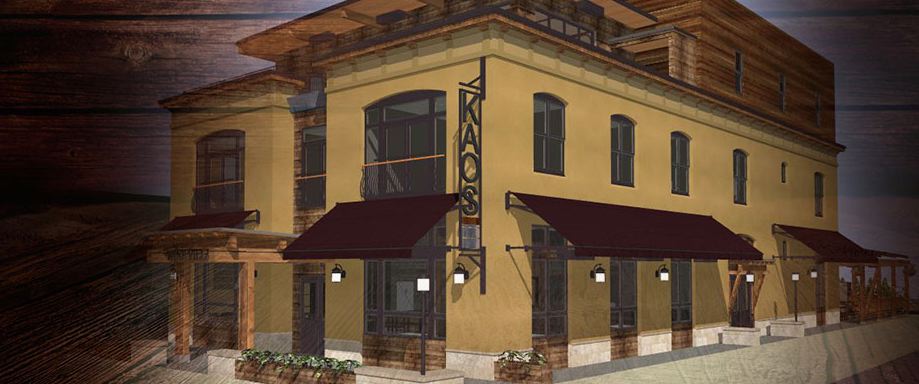
Amelie Robert Climate Update Ernie Pink, "recovering accountant" and now owner and winemaker at
Amalie Robert Estate in the Willamette Valley community of Dallas, writes a periodic Climate Update
(Amalie Robert Estate Farming Blog, aka FLOG) online which he sends out to subscribers. He goes into great
detail about Oregon climate each vintage accompanied by beautiful photos.I can recommend the read highly. In the latest 2015 Mid-August Climate Update, he
calls the 2015 vintage, “Hell-bent for leather crop,” and bemoans he will have to determine how to thin the crop.
He presented an interesting graph of the Year to Date August Degree Day Comparison. Amalie Robert has
logged a growing season accumulation of 1,710 degree days. By comparison, the 2010 and 2011 vintages
accumulated less than 1800 degree days for the entire growing season. 2015 is on pace to eclipse the
warmest vintages since 2003. Follow this link for Amalie Robert Estate FLOG (Farming bLOG):
www.amalierobert.blogspot.com.
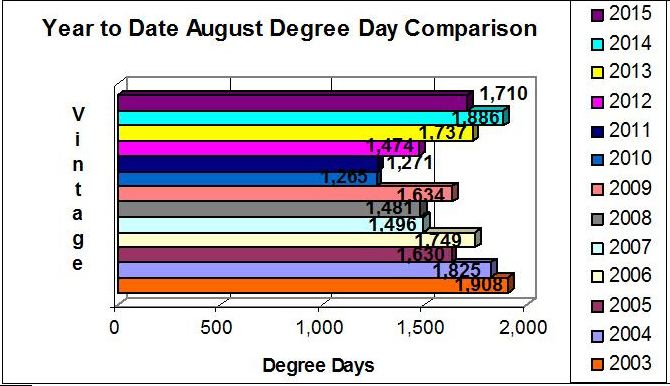
Oregon Wine Industry By The Numbers (Source: “Clink! A Brief History of Wine in Oregon, editor
Enid Spitz). I am not sure what year these statistics were compiled although I believe them to be fairly recent.
AVAs: 17
Varietals: 72
Percentage of vineyards by acreage certified sustainable: 47
Producing vineyard acres: 24,500
LIVE certified vineyard acres: 7,311
Demeter® Certified Biodynamic® vineyard acres: 1,000
USDA organic vineyard acres: 1,409
Certified Salmon Safe vineyard acres: about 6,300
Wineries: about 545
Wine industry value: 2.7 billion dollars
Jobs in Oregon’s wine industry: 13,500
Linfield College Wine History Archives In 2011, Linfield College established the Oregon Wine
History Archive (OWHA) to preserve and document the Oregon wine industry. Wine organizations represented
in OWHA include Erath Winery, Ponzi Vineyards, Amity Vineyards, WillaKenzie Estate, Sokol Blosser Winery,
the IPNC, the Oregon Wine Board and Oregon Pinot Camp. Students, researchers and wine aficionados all will
find items of interest and importance. The collections are growing and more are being added as wine history
continues to be made.
For questions or appointments, contact archivist Rachael Woody at rwoody@linfield.edu or 503-883-2734.
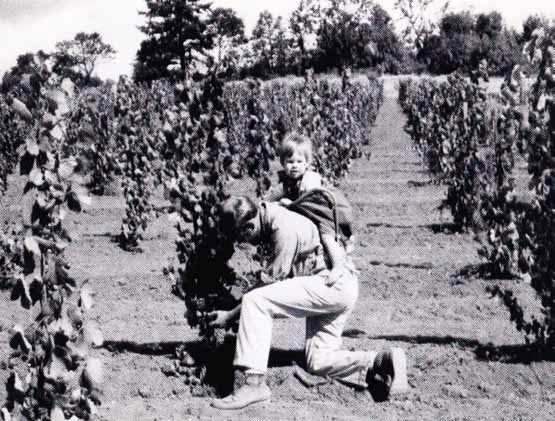
Willamette: The Pinot Noir Barrel Auction A major new wine auction will be held in Oregon next
year to raise the profile of Oregon Pinot Noir. Small lots from the 2014 vintage will be offered as part of a
three-day program with auction to be held on April 2, 2016, at The Allison Inn & Spa in Newberg. The auction
will be an invitation-only, trade (retailers, restaurateurs, and distributors) event will feature open houses for
special tastings at more than 60 wineries and many of these wineries will also offer unique Pinot Noir offered in
5, 10 and 20-case lots. Wineries participating in the auction include Adelsheim Vineyard, Anne Amie Vineyards,
Antica Terra, Beaux Frères, Berström Wines, Chehalem, Cristom Vineyards, Domaine Drouhin Oregon, Elk
Cove Vineyards, Erath, King Estate Winery, La Crema, Lemelson Vineyards, Penner-Ash Wine Cellars, Siduri
Wines, Sokol Blosser and Trisaetum Winery. Josh Bergström is the Auction Committee chairperson.
Assigning Color to Pinot Noir is a Challenging Job
I have been tormented for some time about the challenging job of describing the color shades of different Pinot Noir
wines. Varying from a blush red to a deep violet color, I search for the proper term such as cherry, cardinal, crimson, scarlet,
carmine, burgundy, brick, or ruby. These are all terms used for shades of red. Usually I defer to the
description, “reddish purple,” the most suitable color description for me, but I could just as easily use the
terms brick, sangria, wine or currant. In color thesauruses I looked at, many terms are employed for different
shades of reddish violet or reddish purple.
I recently discovered some information that eased my angst. As a retired eye physician and surgeon, I probably
knew this at one time, but it had been lost in the recesses of my aging memory. The gene that allows us to see
the color red is on the X chromosome, of which men only have one. Women, who have two X chromosomes,
can see more shades of red than men. They can see crimson, cardinal, ruby and scarlet, but men only see light
red and dark red. That’s why women can discern among the multitude of shades of red lipstick.
Since becoming alert to this genetic fact, I realized that for Pinot Noir, it is more important to give a description
of the density of the wine’s color rather than a precise description of the color. That is, the use of the terms
“light, moderately light, moderate, moderately dark, or dark,” are more important than nailing the exact shade of
color.
Perhaps the best approach when meeting a lightly colored Pinot Noir is just to say, “Light Pinot Noir in color in
the glass.”
|
|




